-
Rabo de Toro
Rabo de Toro (Bull’s Tail or Oxtail Stew)
Serves 4 — Needs 3-4 hours of long, slow cooking
- 3-4 lbs of Oxtail (beef short ribs, or stewing beef)
- 3 large Carrots, sliced
- 1 large Onion, diced
- 1 Red Pepper, diced
- 1 good-sized Leek, diced
- 2-3 Ripe Tomatoes, diced (or use canned)
- 4 cloves Garlic
- 2 cups Beef Stock
- 3 cups good Red Wine
- 2 Bay Leaves
- 2 Cloves
- 1 tsp Paprika
- Salt & Pepper to season
- Flour to coat
- Olive Oil
- Heat a good splash of Olive Oil in a heavy pan (cast iron is good)
- Season Oxtail with Salt and Pepper, and lightly coat in flour
- Sear on all sides over a medium heat (about 30 seconds each side) till golden brown.
- Remove meat and set aside to rest.
- Add Leek, Onion, Garlic, Red Pepper and Tomatoes to pan (add more Olive Oil if needed) and saute about 10 minutes.
- Add Carrots, Bay Leaves, Paprika and Cloves – saute 1 minute more
- Return Oxtail to pan and pour in Wine and Stock – liquid should totally cover the meat
- Bring to a boil then reduce to a simmer – cover and continue to cook on low for 3-3½ hours, checking periodically to prevent scorching. Casserole can be baked in a 250C oven instead, or in a Pressure Cooker, with time adjusted. Meat should be tender – almost falling off the bone.
- Carefully remove meat (also the Cloves and Bay Leaves). If there is too much fat, skim off, then puree the sauce with a hand blender and adjust flavouring.
- Serve over Rice, Mashed Potatoes … or as in Spain over Roasted Potatoes.
- Flavour is even better the next day. Freezes well.

-
Paella a la Valenciana
The word Paella refers to the round, shallow metal pan the dish is cooked in … the all-important question is, what should go into an authentic paella? As you can imagine, this seldom brings two answers the same. The original paella came from the shores of the Albufera river near Valencia and consisted of beans, snails and eels along with rice, olive oil and water. What locals of the time had in plentiful supply. Today, Valencians will throw up their hands in horror at the Barcelonan style of paella – which contains almost every kind of meat, fish, shellfish, sausage and vegetable – and remain steadfast in their principle that simplicity is best. They consider red pepper overpowering and wouldn’t dream of mixing chicken and fish!
The recipe below is somewhat of a compromise, but feel free to add whatever ingredients you have to hand … after all, that was the true origin of paella.
PAELLA VALENCIANA – servings 4-6
- 4-6 chicken thighs
- small section of Chorizo sliced (other sausage or ham is fine too)
- 1/3 cup olive oil
- 1 medium tomato, peeled, deseeded and chopped (or canned diced with liquid removed)
- 2 cloves Garlic, minced or grated
- 1-2 tsp of Paprika (I add a little smoked Paprika as well)
- 1 cup Green Beans, chopped
- 1/2 cup of Red Pepper, diced
- 1/2 cup Peas
- 2 cups Rice (short grain is traditional, although long grain is quite acceptable)
- 4 cups of boiling water or stock with a good pinch of Saffrom
- 12 large Prawns (cooked or raw) you could use Mussels or Clams
- Salt and Pepper to taste
Using a large frying pan, season chicken with salt and pepper and fry briskly in olive oil over a moderately high heat till browned. Add the tomato, garlic, beans, peas and sausage. When this has browned a little reduce heat to medium and add the rice and paprika, mixing well. Continue to fry while water/stock comes to a boil. Add hot liquid to rice mixture and stir briefly to mix (don’t overmix or rice will become sticky). Adjust seasoning and cook on high for about 5 minutes (careful not to burn). Arrange prawns or shellfish on top. Cover with a lid and turn heat way down – I actually turn the heat off), and allow to cook slowly for 12-15 minutes. If the rice has not absorbed all the liquid at this stage you can remove the lid and briefly turn the heat on just a touch. Do not be tempted to stir, or the rice will turn mushy.
Let rest 3-4 minutes before serving.
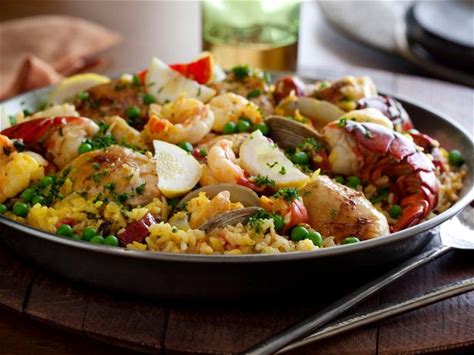
-
The Classic – Flan
After 8 weeks in Spain, this simple, but delectable dessert, eluded us. Every restaurant inquiry brought the same response – Lo Siento, no. There were stacks of manufactured versions available in every supermarket with flavours ranging from chocolate, coffee, orange and plain … and some were quite good … BUT these were not the quality I remember (or make at home). So here is the recipe I use – simple, easy (as long as you get the caramel right) and delicious.
6-8 Servings (depending on size of dishes) – Salmon Canning Jars or small heat-proof dishes, greased
- 2/3 cup of Sugar (for caramel)
- 1 cup Sugar (for custard)
- 4 cups whole Milk
- 4 large Eggs – room temperature
- 1 cinnamon stick broken in pieces
- 1 large piece of fresh orange peel
Preheat oven to 375C.
Simmer milk slowly for 10 minutes with 1 cup sugar, orange peel, and cinnamon stick – do not boil. Meanwhile make the caramel by melting 2/3 cup of sugar in a small, heavy-bottomed saucepan over a medium-low heat. Watch constantly and shake pan back and forth so that sugar turns an even medium brown colour as it melts, but doesn’t burn. IMMEDIATELY pour a little caramel into each dish — don’t worry if it doesn’t cover the bottoms entirely – it will during baking.
Let milk cool for a few minutes before straining into gently beaten eggs – STIR constantly while adding to prevent ‘cooking’ the eggs. Blend well and re-strain to remove any solid ‘eggy-bits’. Carefully pour mixture into dishes and remove any air bubbles.
Place filled molds into a large pan of cool water — water should cover the bottom 2/3 of molds. Loosely cover with a sheet of foil and bake in centre of oven for 30-45 mins or until done — custard should jiggle like a jelly. If water starts to boil, but the custards are not cooked, just add a little more cold water.
Carefully remove custards and allow to cool to room temperature before chilling in the fridge. To unmold, gently run a knife around the sides of the custard, place a plate over the dish and quickly invert. Give a good, hard downward shake, until you hear it loosen and you’ll see all that luscious sauce as you gently lift the dish. There may be be a layer of hardened caramel left behind – but just soak in wash water – it will dissolve. Custards can be served with a dollop of whipped cream . . . but they are perfect as is.
Other flavours:
Orange & Lemon – remove cinnamon and add peel from half an orange and half a lemon
Vanilla – omit cinnamon stick. Add vanilla bean broken in pieces or a tsp of essence.
Rum – replace cinnamon and peel with 3 tblsp of Rum and half a vanilla bean.
Coffee – omit cinnamon and peel, and replace with 3 tblsp of strong espresso coffee.
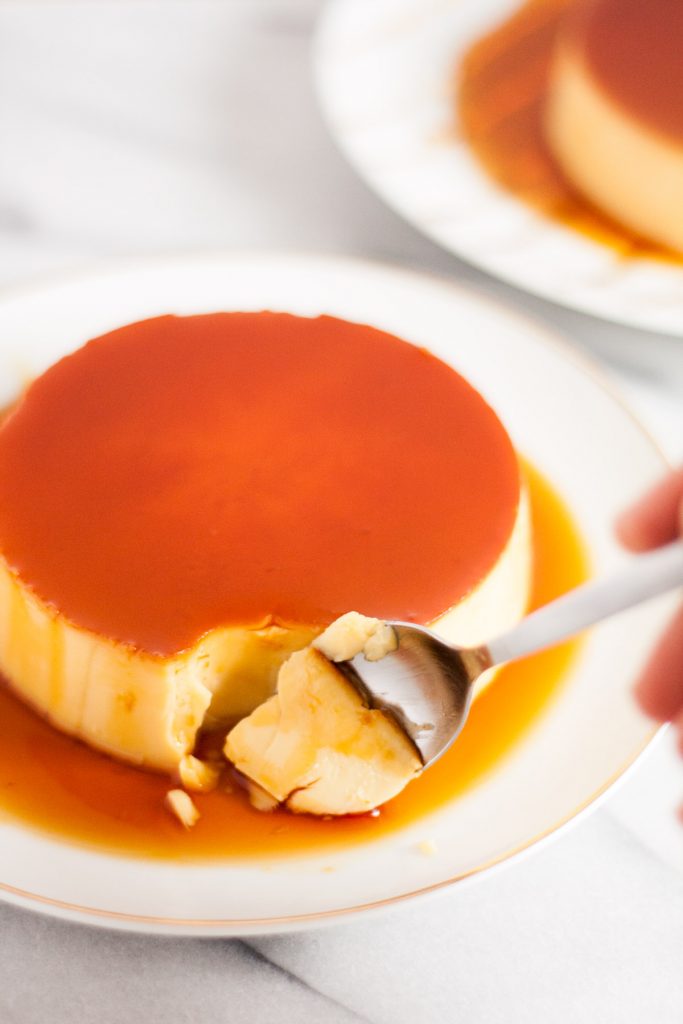
-
The Capital – Madrid
We could see the train station from the end of the street so it was a mere 10 minute walk, trundling our cases behind. The easiest check in ever, and a smooth journey north.
Definitely cloudier and cooler in Madrid … glad of our jackets now. Majestic buildings sporting huge heraldic beasts wherever you look. Glen skidded to a stop in front of one store front … “Look!” he exclaimed … “a spring store”, and sure enough a shop selling every type, size, shape, colour and vintage of mechanical spring. Who knew!
Our apartment for the next 3 days is right in the heart of the city … walking distance to all the museums, like the Prado … vast city parks …. there are 46 public markets if one felt so inclined. As the weather was predicted to turn rainy, we dumped our bags and went out to explore. Elegant, well-kept buildings in pastel shades — their shutters and balconies a darker contrast. A market place designed by Monsiuer Eiffel himself .. not your usual market — this one was upbeat and trendy with counters groaning under a mouth-watering array of ready-to-eat tapas. Might be good to try later.
Madrid’s massively domed cathedral sat directly opposite across the square from the Royal Palace. Resplendent behind black and gold gates, it presented an impressive view with its 3000+ rooms and vast courtyard. Reportedly the largest palace in Europe.
As darkness fell, lights sprang up all over, and a gentle rain began to fall. We ducked into a small restaurant called Gloria Bendita … gloriously eclectic, but with wonderful aromas wafting out of the kitchen and attentive staff. We ordered a vegetarian ‘tartare’ salad … tiny chunks of mango, avocado, onion, cilantro and citrus … bursting with freshness and flavour. This was followed by pork cheeks simmered in a rich house sauce of umami-goodness and topped with strands of crisply deep fried onion. It was so good, that if we were at home, the bowl would have been licked! Thankfully there was a basket of warm bread rolls to mop up all that deliciousness. A small portion of the salad was waiting to be finished, when the waiter began to clear it away … “Nooo!” we cried in unison. He grinned and backed away. Small glasses of digestif were brought with the bill … a chilled, homemade version of Bailey’s Irish Cream … but oh, so much better.
The rain had stopped, and it was a pleasure to walk home through glistening streets splashed with colour from the shopfronts.
There was a breakfast delicatessen/bakery/coffee shop Granier just steps away from the apartment, so Glen descended in the funny, creaky elevator and went in search of coffee. Came back with croissants as well! A day starts off really well with good coffee and probably the BEST croissants we’ve ever had … even in France.
Colder today, and although not raining, it looks as though it could so we pocketed some disposable rain capes just in case. We’re off to the Prado — time for a little culture — but the aromas from a small bakery (Levaduramadre) assailed us first and we just had to buy some meat pies for lunch first. It’ll be a carb overload today, but who cares!
Autumn has arrived … all the leaves are being blown around by a chilly wind. Boaters on the pond looked positively frozen … but the ducks and geese seemed to be having fun. We found a reasonably sheltered bench in the big central park to consume our delicately spiced beef pasty. There’s a definite police presence around the city, even here in the park. I gather there was a huge protest with hundreds of thousands, just before we arrived. All the streets and shops now are being seriously decorated for La Navidad … lights strung across the streets … beautiful living ‘Christmas trees’ made up of colourful potted plants … all the squares and plazas are a hive of activity as cranes maneuver large festive panels and figures into place. This in addition to the other restorations taking place all over the city.
The Prado … is wonderful … even for non art connoisseurs. It’s helpful to see whole collections by a single artist to get a feel for their skill and style. All the major artists were there (only one Picasso though), but many of the lesser known painters were well represented too. Unfortunately, like most exhibits … photography is not permitted. This is a brilliant link to all the collections though: https://www.museodelprado.es/en/the-collection/ It was a truly memorable visit. The rain capes came in handy on the way home.
The next day started dry so we hopped aboard local buses and explored some more . . . however many of the ‘must see’ attractions – like the Plaza Mayor appeared to be under renovation and were cordoned off, and it was difficult to move against the tide of people heading in the other direction. The rain returned with a vengeance … and perchance we found ourselves outside Gloria Bendita again. This seems to be our bolthole in the rain. Coffee and a simple but delicious dish of beautifully roasted potatoes drizzled with a creamy piquant sauce, whiled away the time before our tour of the Royal Palace. Perfect for a rainy afternoon.
Visitors had to go through security, so we fumbled our way out of dripping rain capes and deposited our belongings onto the x-ray conveyor belt before being allowed entry. And goodness … what an entry hall and staircase! Again, no photography allowed, but you can see some here: https://en.wikipedia.org/wiki/Royal_Palace_of_Madrid Not the best quality video but gives you an idea. Best viewed on a smaller screen: https://youtu.be/0mC_nEBJeQI Every room had ceiling paintings and was decorated with different coloured marble — red, green, golden brown. All the artwork had gilded frames … there were exquisite silk wall coverings and antique vases from China tucked in corners. I gather it is no longer the actual residence of the Royal family, but used for State events. It would certainly be intimidating to live in such a place — hardly cosy!
We’ve come to the end of our time in Spain … 8 wonderful weeks … and so many memories to take home. Thankfully we decided to leave extra early and take a taxi to the airport. We chatted to the driver as he weaved through the morning rush hour (our last chance to practice Spanish), and arrived at 9:20 … our flight didn’t leave for 3 hours. We checked our bags and figured it best to get security checks over and done with. The scene that greeted us was far more chaotic than other airports … lines of passengers everywhere … a shortage of trays for belongings … huge bags being stuffed through x-ray machines (isn’t it supposed to be carry-ons only?) … security personnel halting passengers and wiping down hands (back and front) AND waists!!!! What was that for? I had forgotten to remove my money belt, so there was a great excitement as I was to go back and put it in one of our trays – which was rapidly disappearing through the scanning machine flaps. What if it fell out and got jammed? The inside of my backpack was examined and wiped . . . but not Glen’s.
With all our belongings finally collected and reassembled we went off to look for our gate area. In the elevator – we and our fellow passenger peered hopefully at the panel – nothing was immediately obvious which button to push, so we tentatively pressed a few. Arriving one level down it became clear that we now needed to board a train to get to gates M and S. An hour and 15 minutes had elapsed by this point.
Onto the train … up the escalators … more shuffling line-ups … this time for passport checks — and just like at supermarkets, you always end up in the slowest line. Finally through, there was still a long walk to reach gate S-11 and we arrived with just enough time to visit the washrooms before boarding the flight. Three hours, and we needed every minute!
Farewell Spain … we’ve LOVED every minute of our journey … well, maybe not Madrid airport. I’d give it a miss if I were you!
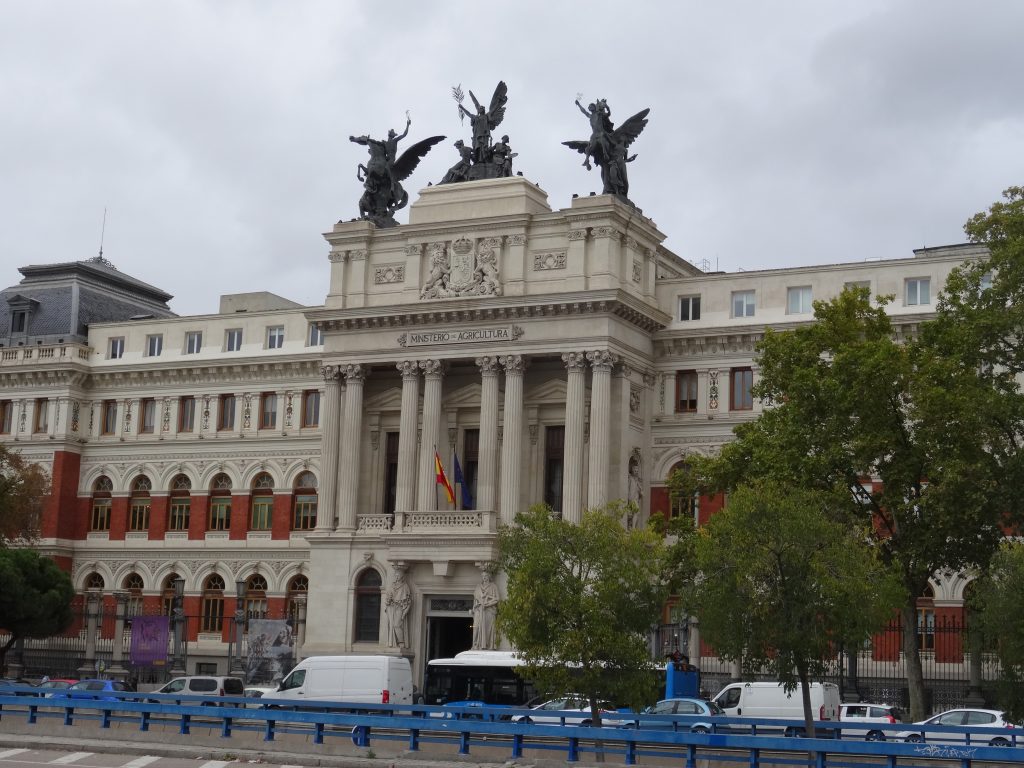
One of the grand buildings – I think it was the ministry of agriculture 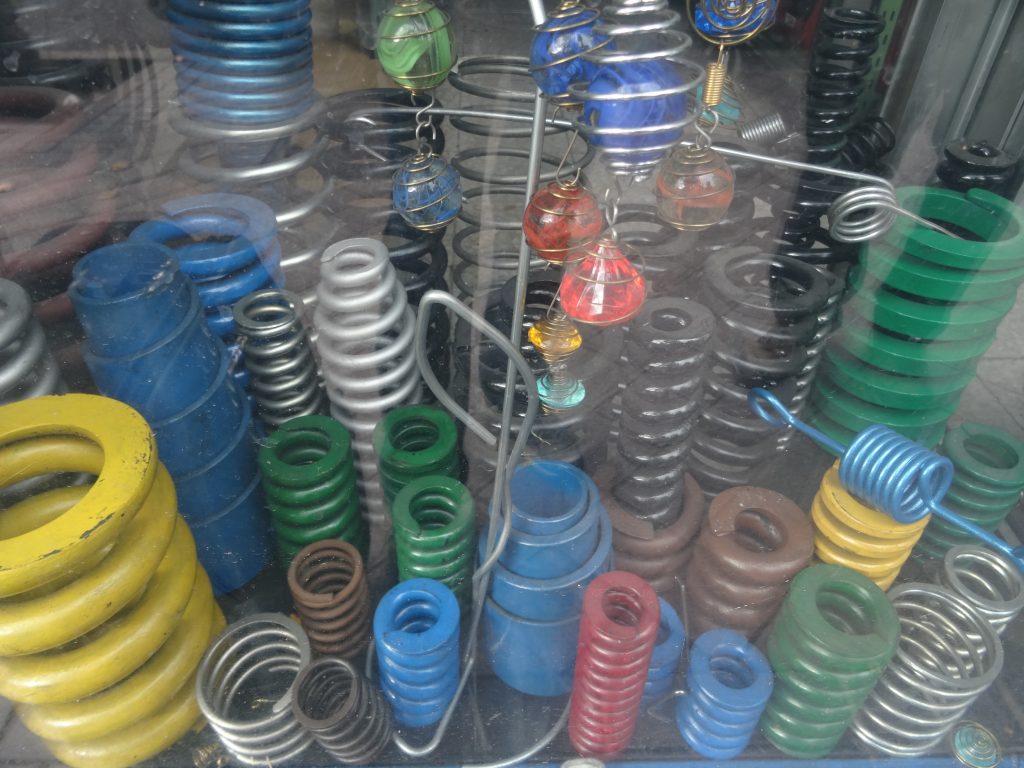
A spring store — who knew 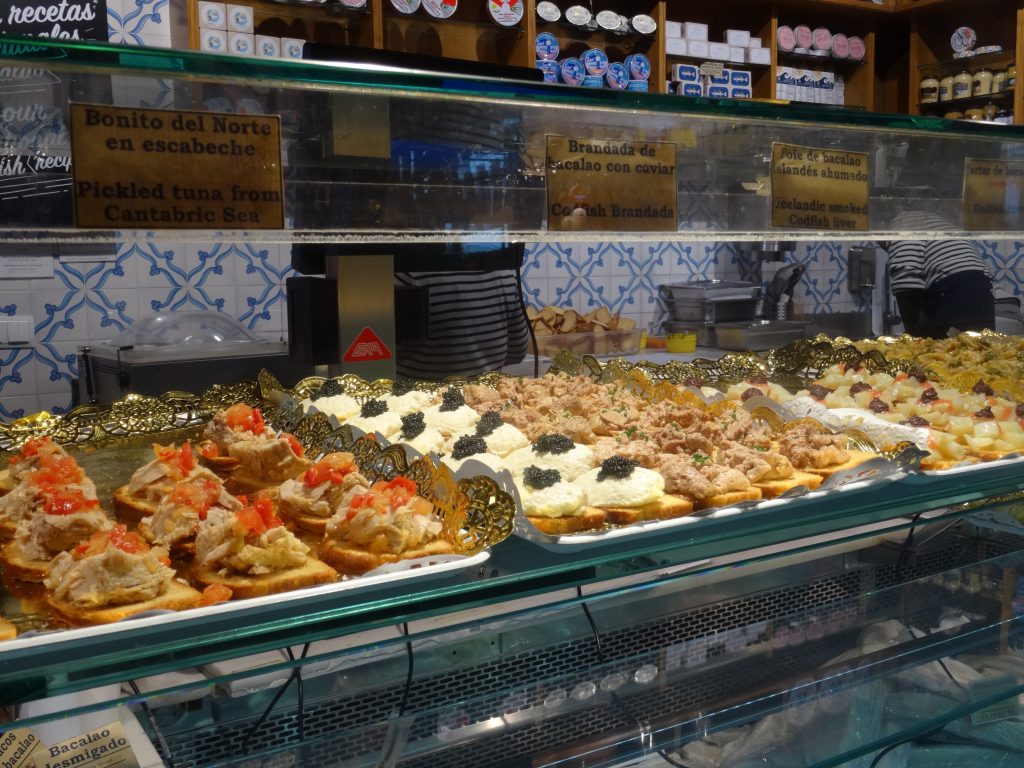
A counter of tapas to eat in or take out 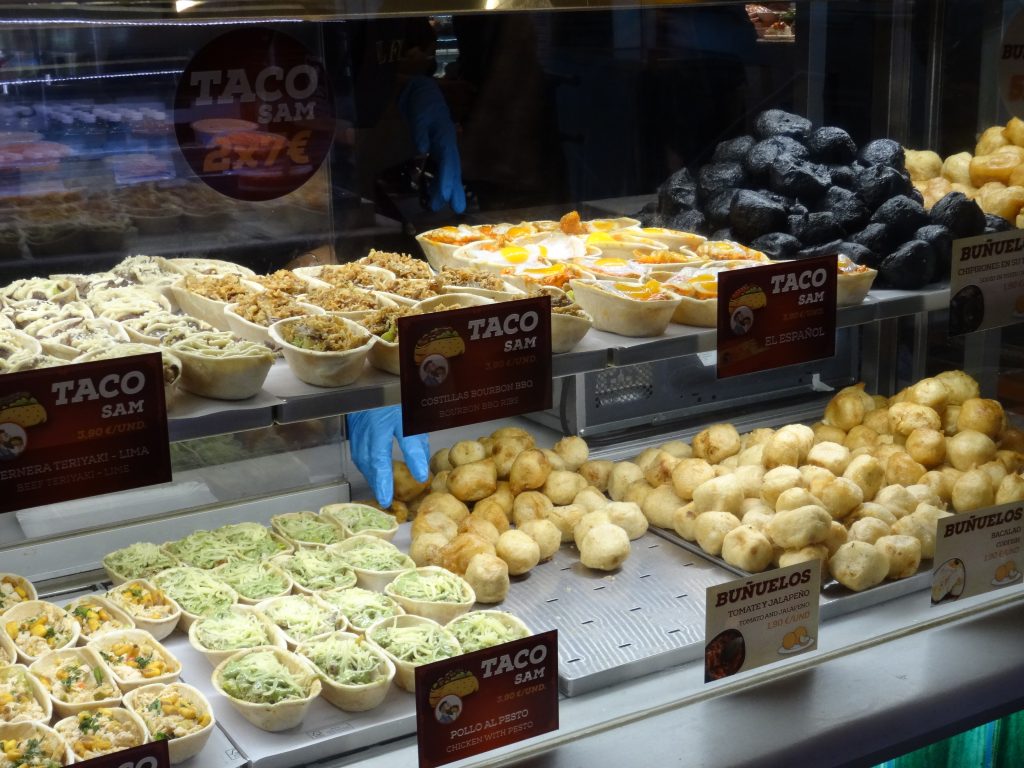
More tapas 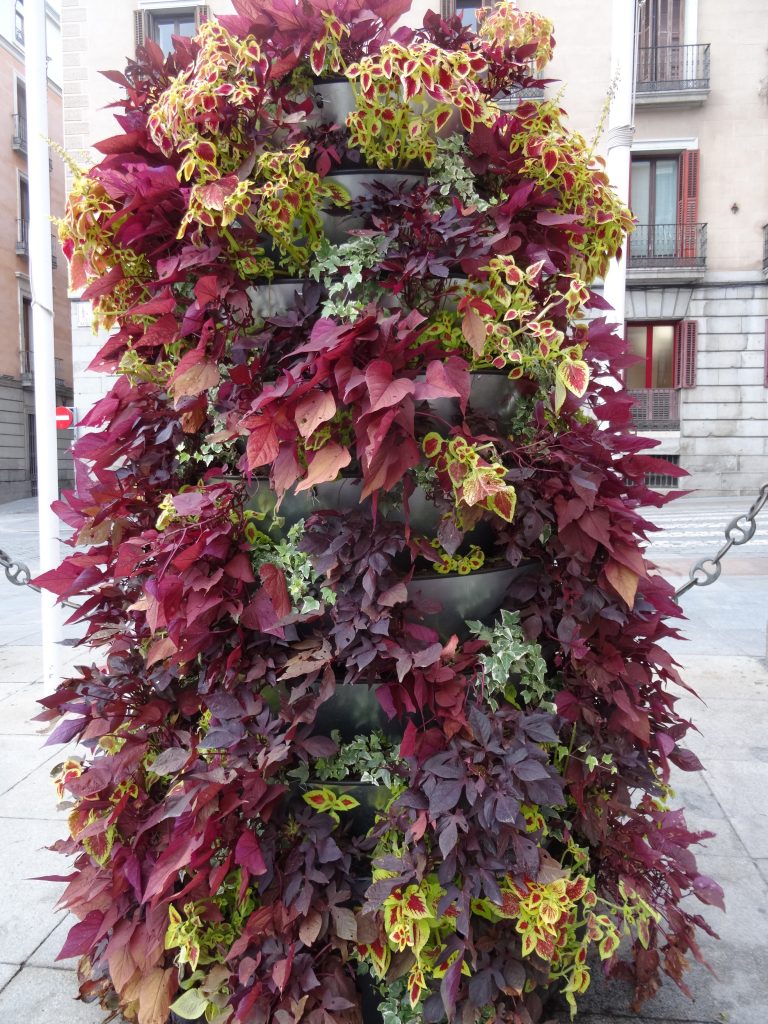
One of dozens of ‘Christmas’ trees 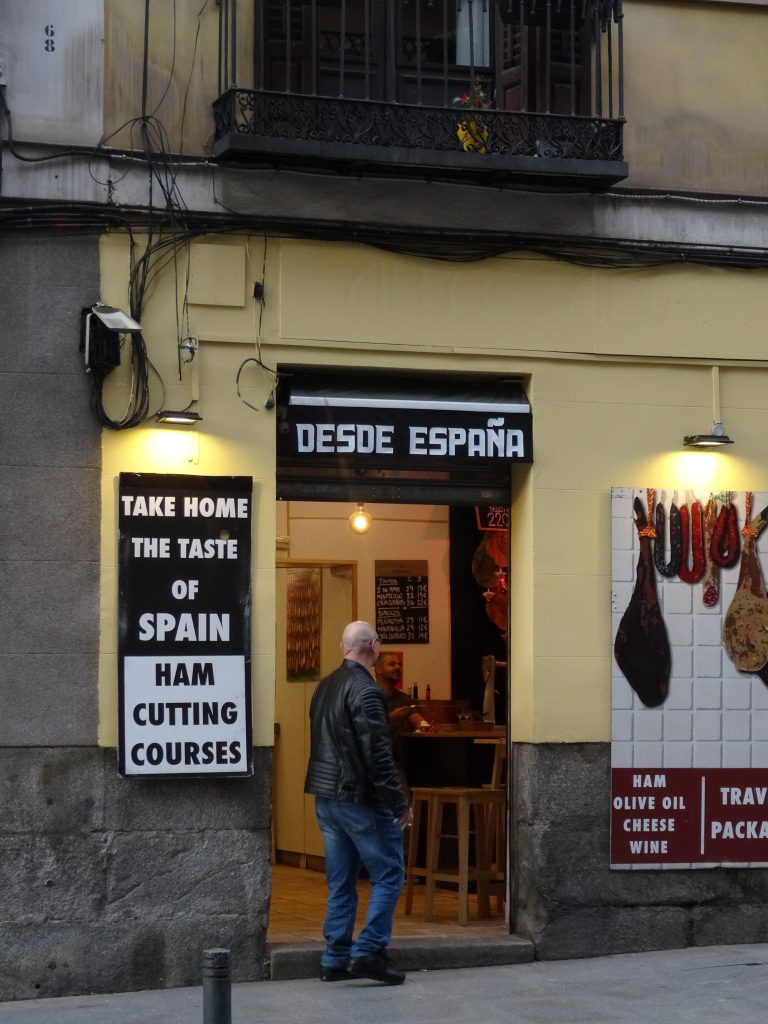
Learn to carve jamon 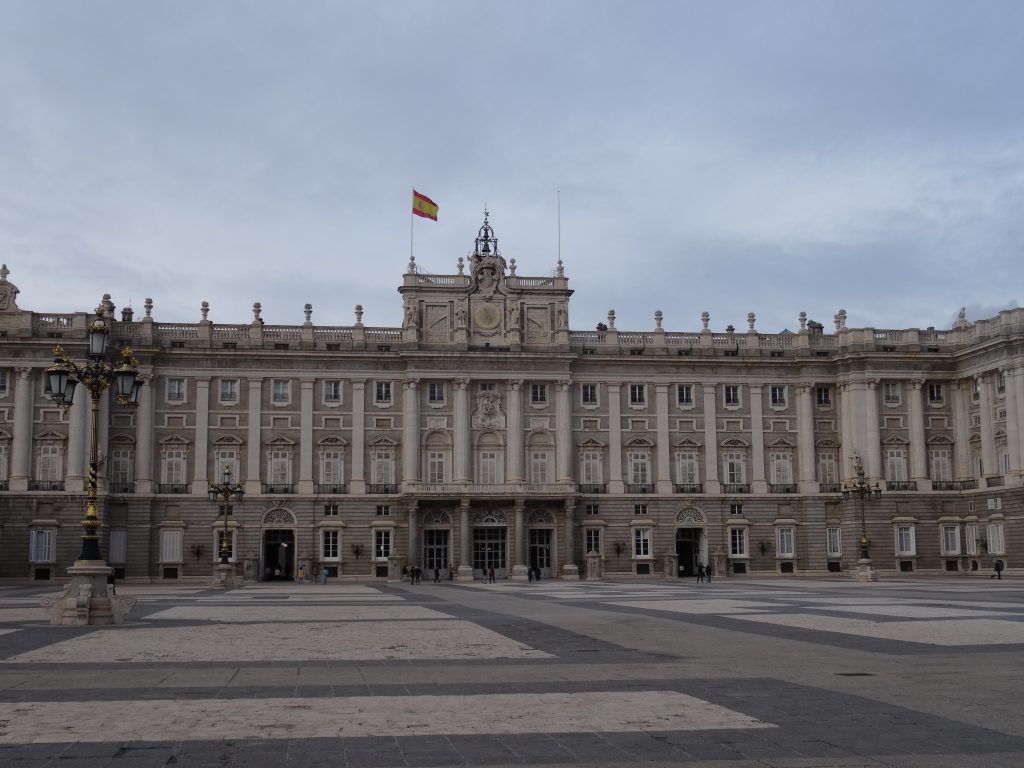
The Royal Palace 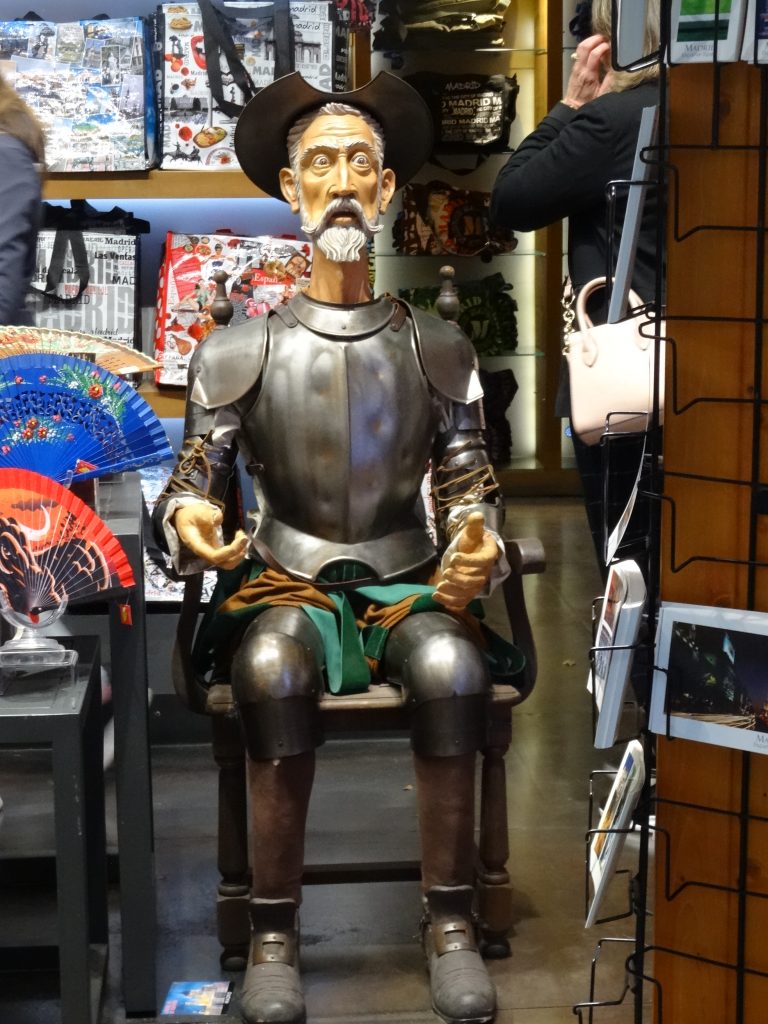
I want one of these but I don’t think he’s for sale 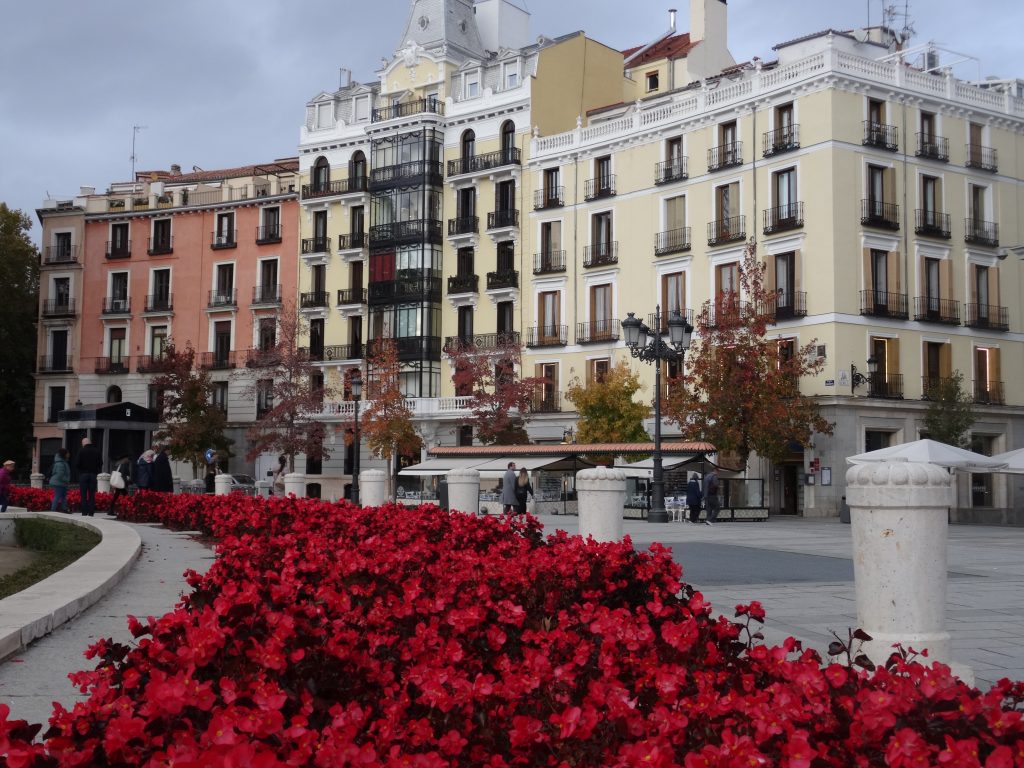
Some of the colourful and elegant buildings 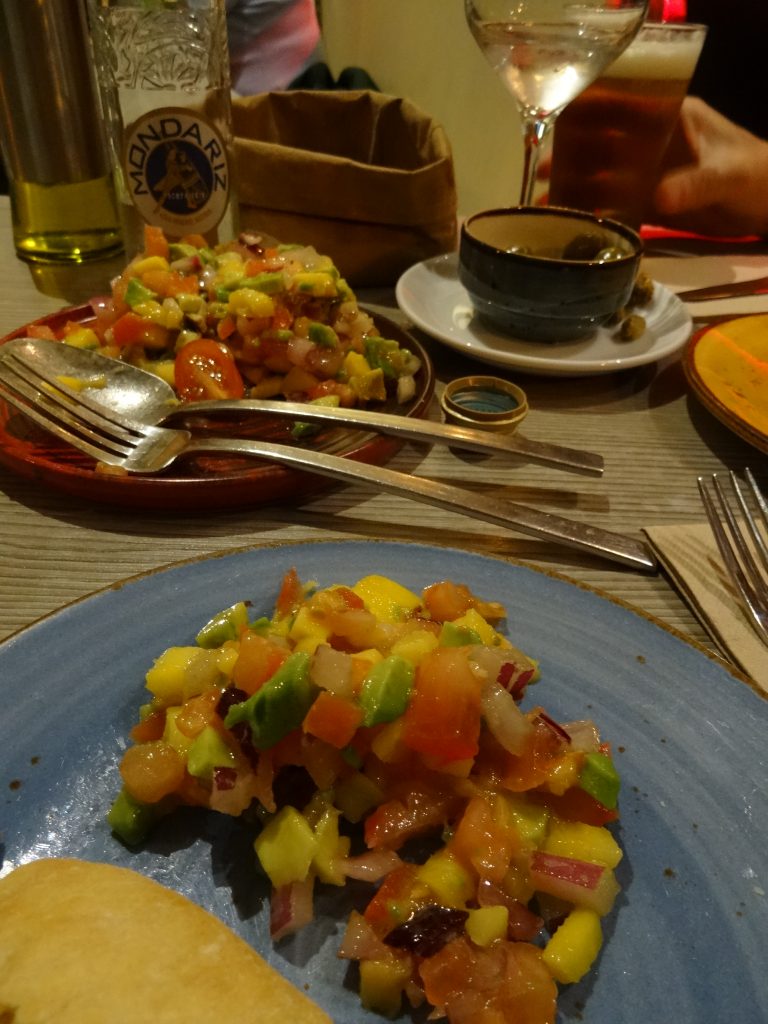
Avocado, mango, red onion and orange ‘Tartare’ salad 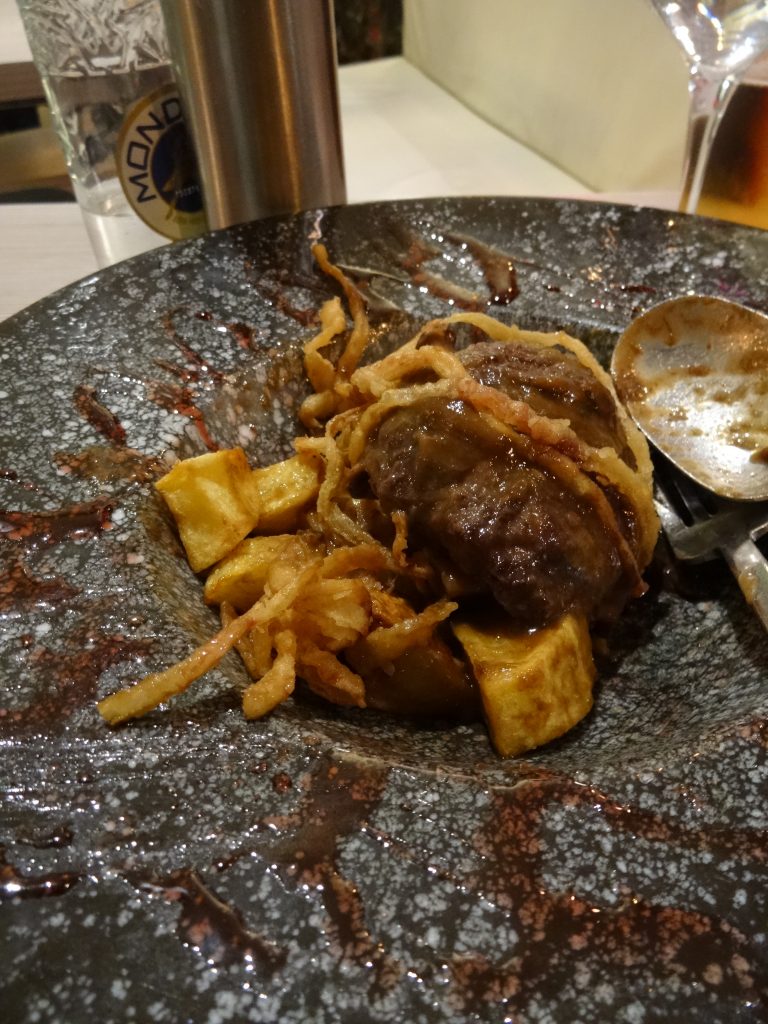
Slow roasted Pork and fried potatoes 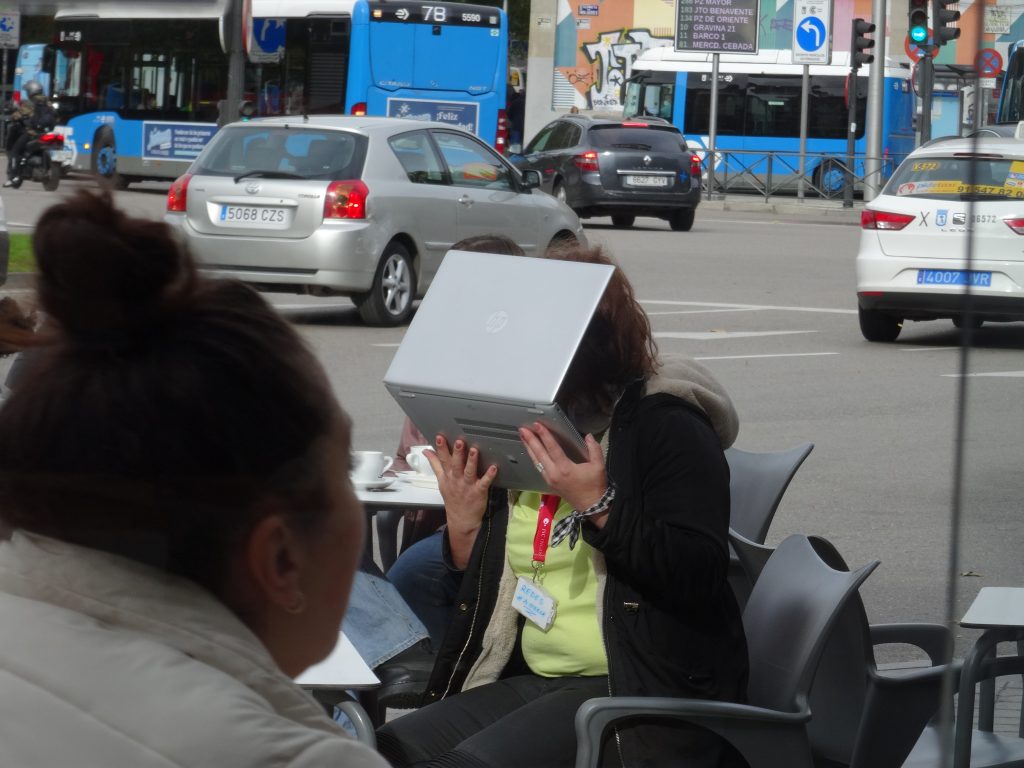
No … I don’t know what she’s doing either 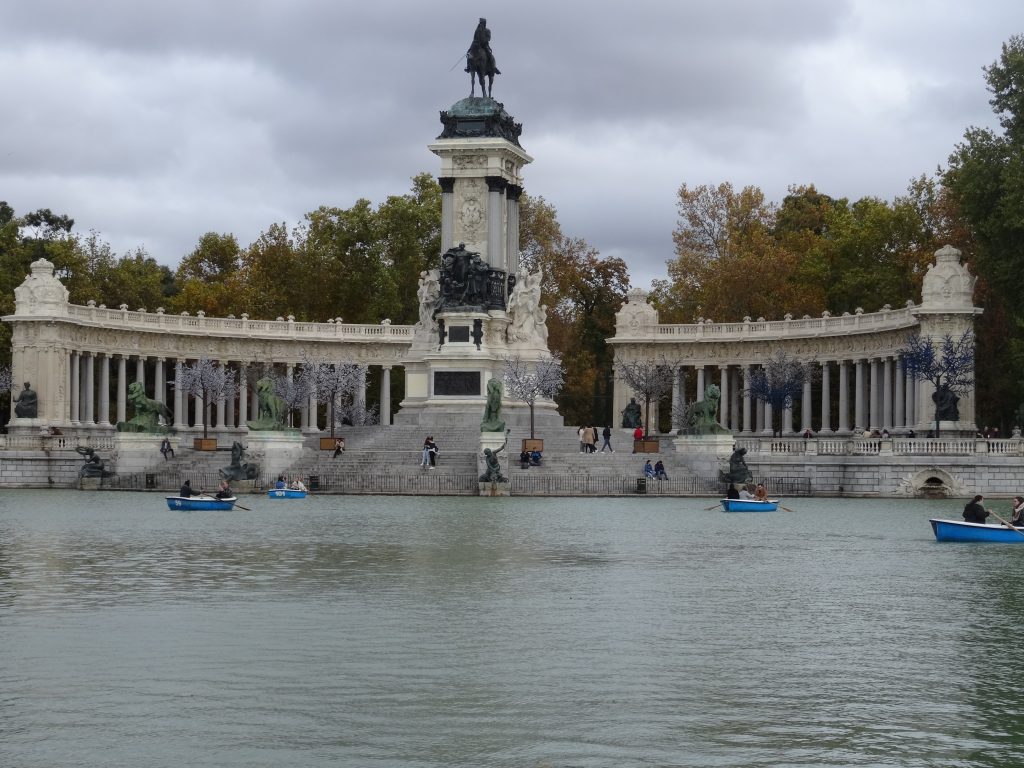
Far too cold for boating 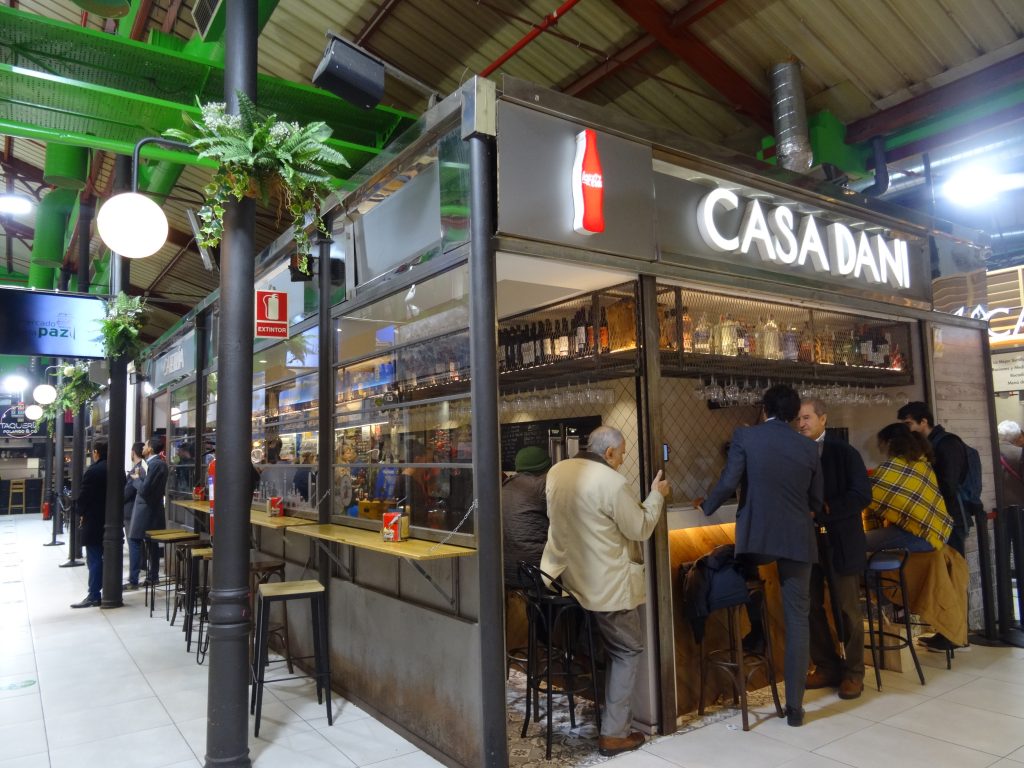
Reportedly the best place to buy a ‘Torta’ … just weeks after we got home they had a massive outbreak of Salmonella! 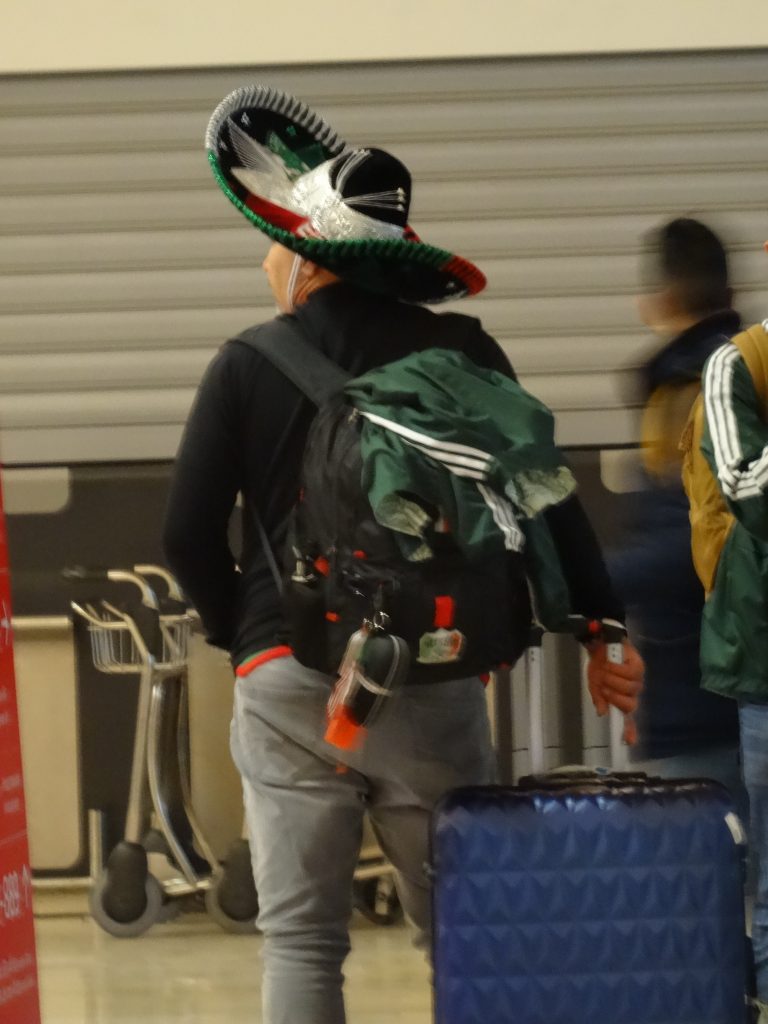
Found standing at Madrid airport – did he take a wrong turn at Mexico? -
Farewell to Granada … and a night in Malaga
A quieter day . . . discovered the loveliest gardens … Carmen de los Matires (Carmen of the Martyrs). Set in their own forest just below the Alhambra. https://www.inspain.org/es/granada/granada/carmen-de-los-martires/
We had the place all to ourselves at first … so tranquil and quiet. A hidden grotto behind a waterfall … patios … formal gardens … an aqueduct supplying water to the whole estate … pomegranate trees in blossom (who knew the flowers were the same shade as the fruit) … a lake with its own castle folly … extensive herb beds … peacocks on the window ledges. What a magical garden this would be for children (not bad for adults too).
For our last evening we had tapas at Meson Andaluz sitting on high stools at a table in a vibrant alleyway Taverna, watching the world go by and listening to strolling musicians .. some were quite talented. Once again free tapas with each beer … jamon drizzled with olive oil on slices of bread … slices of potato torta. Waiters keeping track so you always received a different one. We also ordered a plate of very large prawns on a green salad. Delicious.
Strolling back to the apartment we passed a luthier (sadly closed) with rows of beautiful hand-made guitars … and a plaza with statues and fountains ablaze with lights. Each of the public benches were different … some had companionable bronze statues to sit beside … others with ‘comfortable’ bronze cushions to lean against. Quite fun.
Not so fun was extracting the car from the parking spot the next morning. The underground parking garage was compact in the extreme and had necessitated two sharp right-angled turns to enter, and then literally inching back and forth between 4 concrete posts and a car directly in front of ‘our’ allocated spot. The width between posts only allowed a foot spare on either side … this was ‘helped’ tremendously by the garage being plunged into total blackness every 3-4 minutes as the lights turned off in power-saving mode. One had to shuffle forwards, hands extended till a post was encountered … sometimes abruptly … and the switch pushed. We got smart and kept a flashlight handy. This process was repeated in reverse when we left. Thirty-five agonizing minutes and several very close calls later, we drove out … with many more gray hairs.
Needing to return the car to Malaga we booked an overnight stay, and drove through the Sierra Nevada mountains amid incredible scenery. High curving highways over dams and reservoirs – like Viaducto la Loma, https://www.adurcal.com/enlaces/mancomunidad/guia/puentes/rules/mayo05/index.htm (scroll down for views), deep folded valleys with villages gently cupped at their bases … out to the towns of Motril and Salobrena. This area of the coast is scenic and unspoiled.
The apartment in Malaga was …. outstanding. Called Luxury Apartment, they weren’t kidding. Dazzlingly clean… quality everything… two bathrooms … a lift right to your door … private patio on the roof. What’s not to like? And we only have one night there! Car returned to airport without a hitch and we relaxed on the patio sipping chilled sparkling wine, courtesy of the hosts. Train to Madrid in the morning.
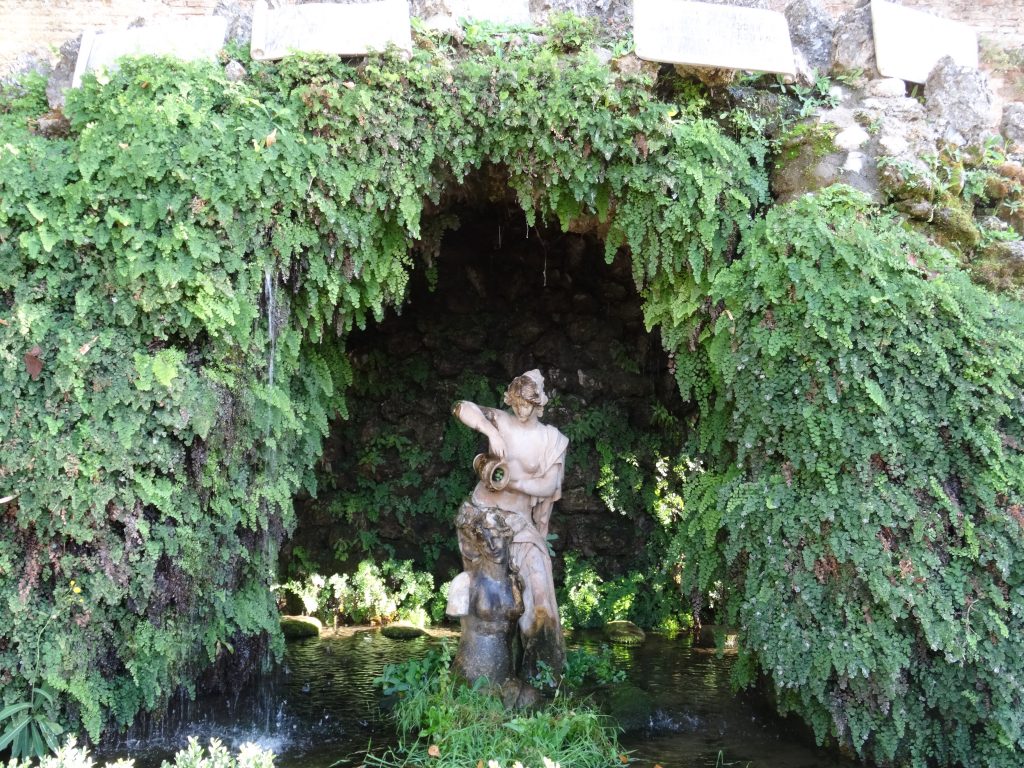
Ferny Grotto 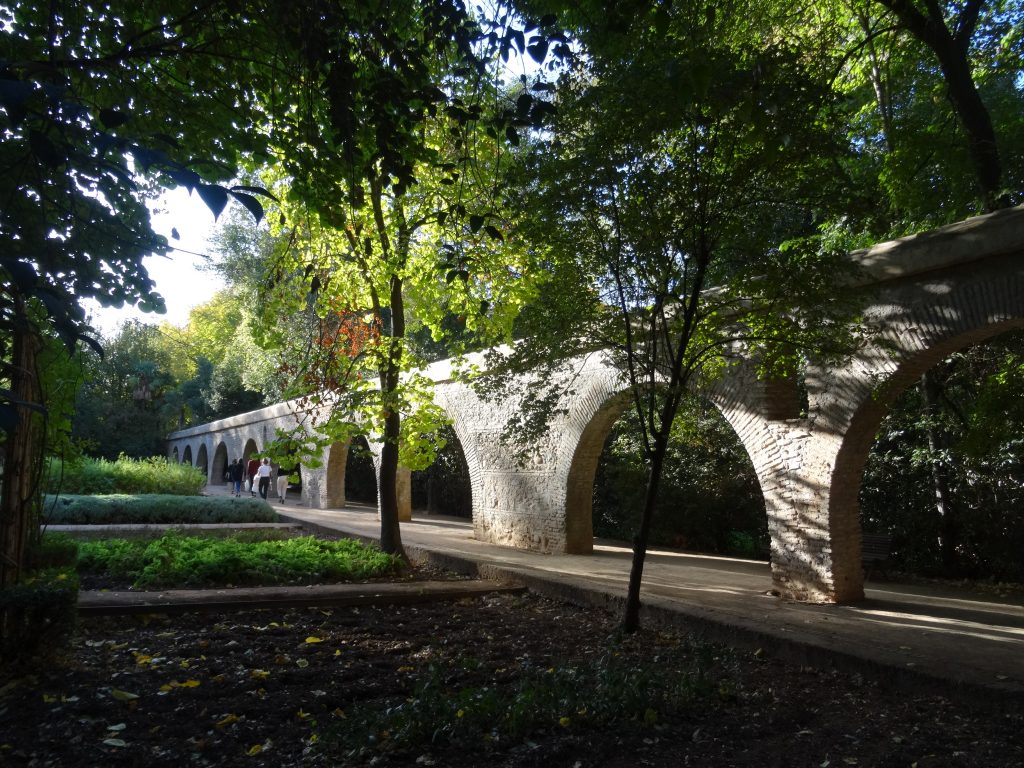
Garden viaduct 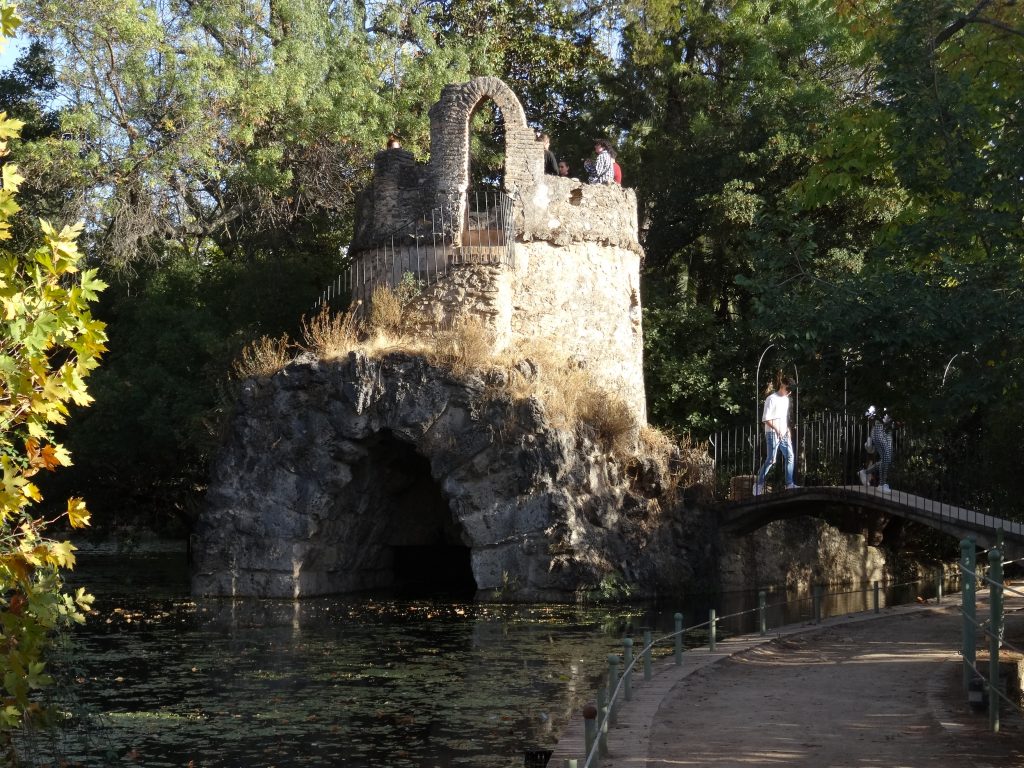
Island Folly 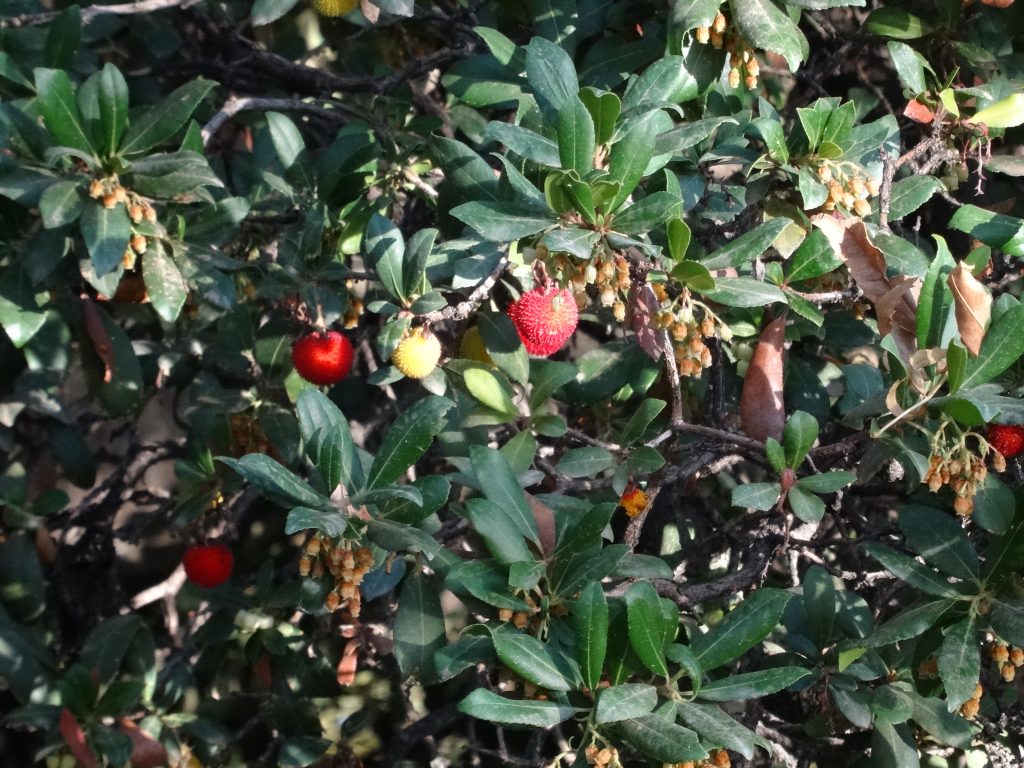
Pomegranates growing 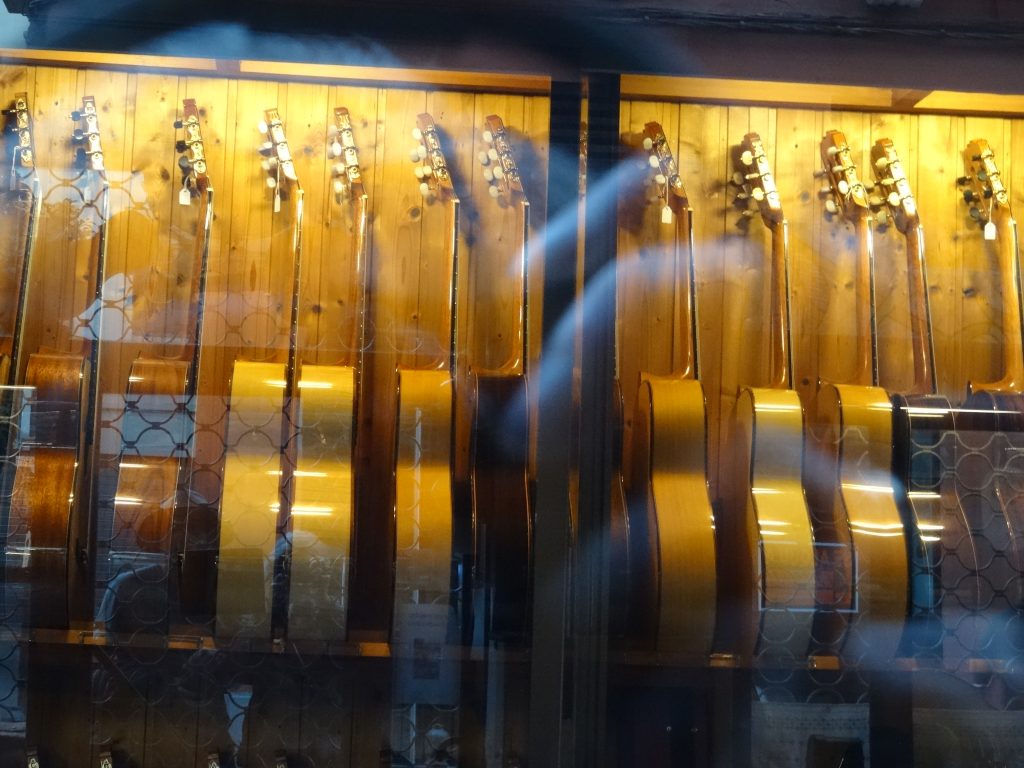
Luthier’s Window 
Tapas Bar 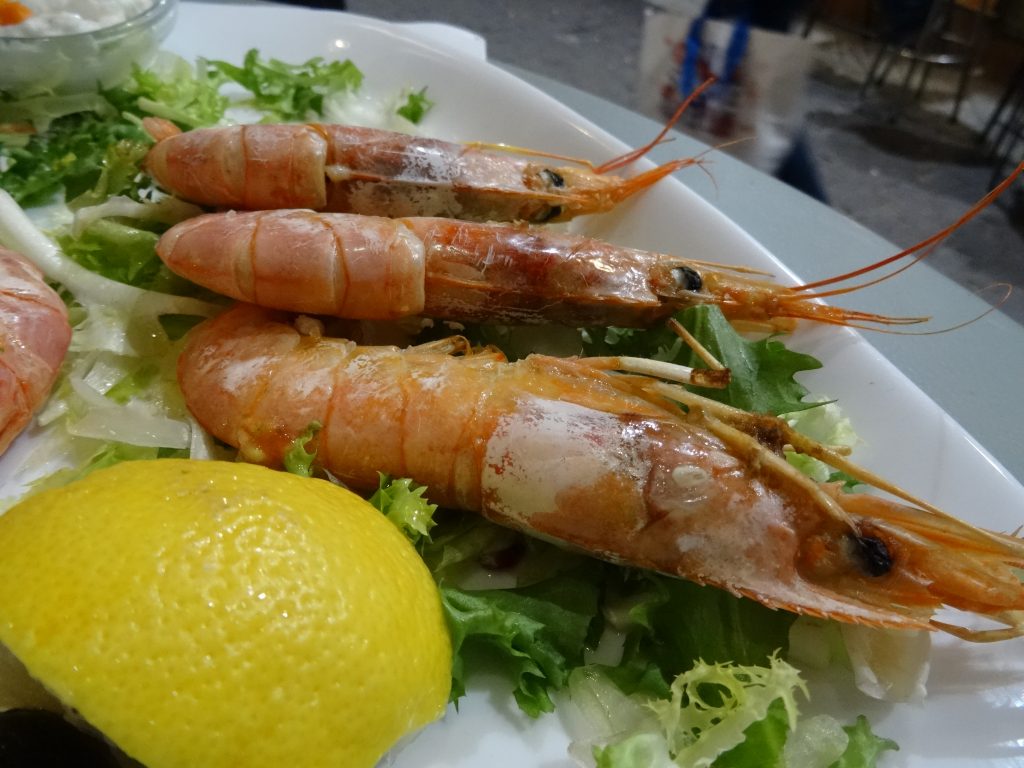
Wonderful gambas 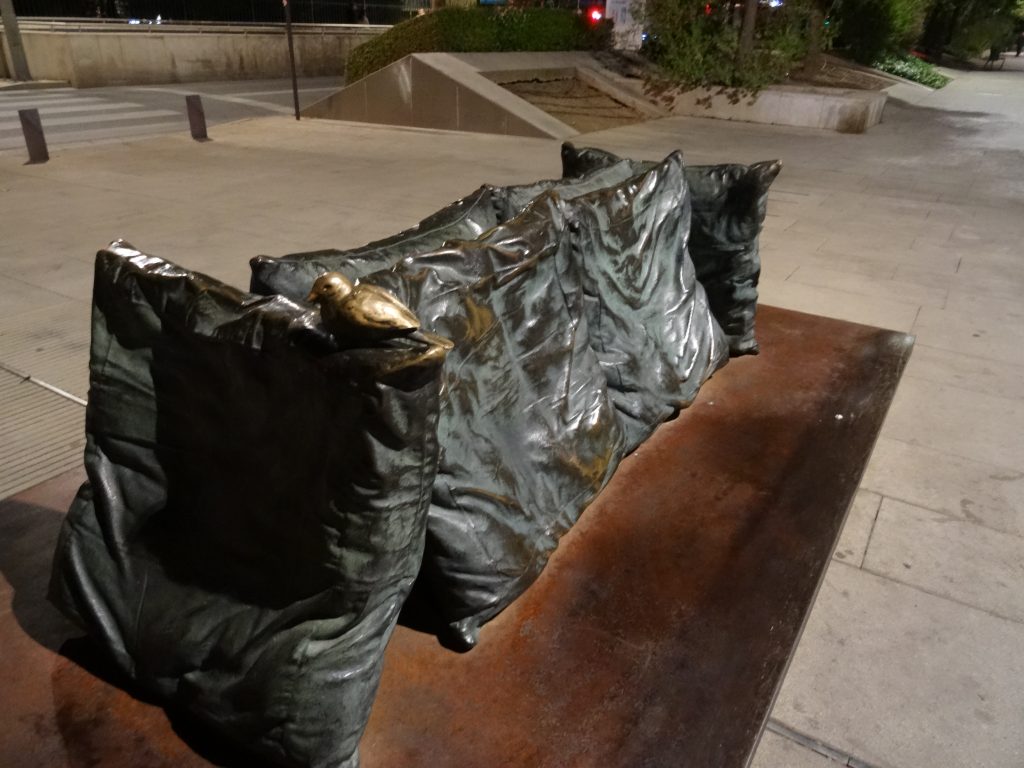
Inviting bench – a little on the hard side 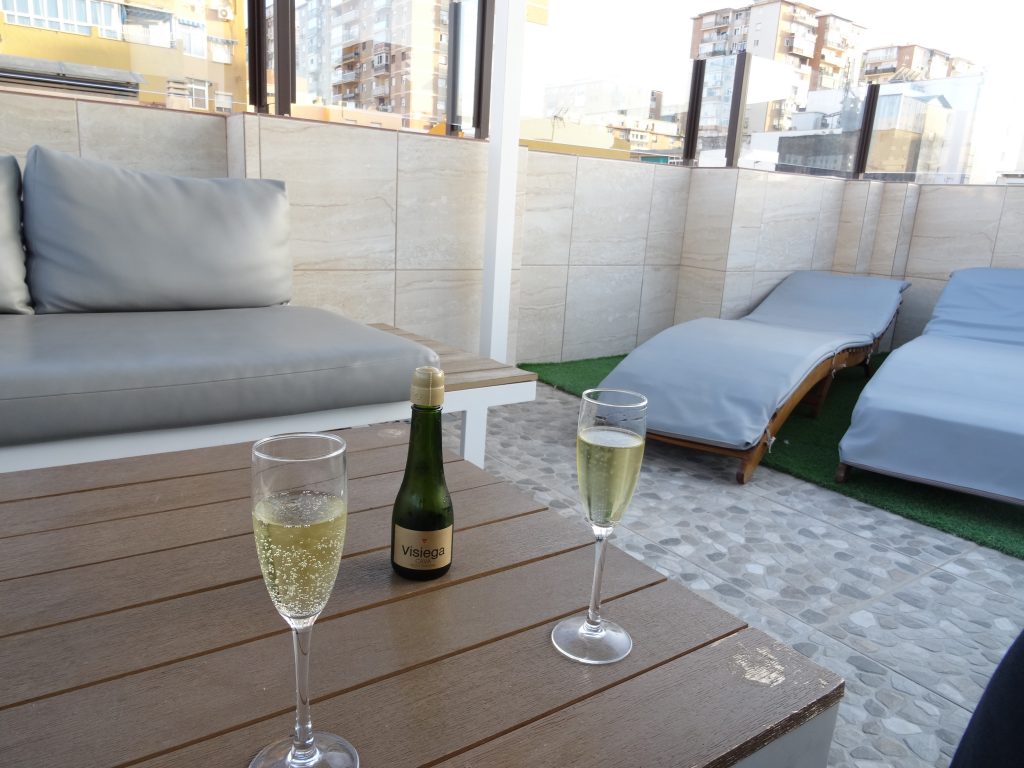
Rooftop Patio in Malaga with bubbly -
The Alhambra
What a gorgeous morning. Transit buses take you right up to the Alhambra — you could walk, but it’s a pretty steep uphill climb. Our tickets for the Nazarine Palace were for noon, and we soon made our way through the line-ups and multiple passport and security checks.
The Alhambra was … well, The Alhambra! Standing proud on it’s cragg with the city spread out below and a backdrop of the Sierras. Magnificent. Without question this has to be the finest example of Moorish architecture in Spain. Intricate carved ceilings made from thousands of pieces of wood … gloriously tiled walls … exquisite molded archways … reflecting pools to sit a contemplate . . . and of course the famous lions fountain. This was being worked on during our visit, but with some careful camera angling we managed to edit out the technician with his computer <grin>. I can remember standing beside this very same fountain as a little girl, but it’s roped off to visitors now. Rick Steeves has a good short video showing the Alhambra: https://www.youtube.com/watch?v=iEseJViidy8
The Generalife Gardens were a welcome break from crowds of people taking photos and selfies. What is it about cell phones that brings out all the narcissistic drama queens, posing with arms outstretched, or pouting coyly into the camera at every view? <sigh> Gardeners were busy trimming hedges using rulers to obtain just the right height and straightness … or raking up the leaves which had just begun to fall. Some hedges were trimmed in a wave pattern – quite effective from a distance. Fall flowers and the sound of water was everywhere.
King Carlos V’s palace was an imposing square building with gigantic rings – like huge door-knockers in the beaks of eagles or mouths of lions – all around the outside walls. Inside was an unexpected two story circular edifice — probably with excellent acoustics. It now houses the Alhambra museum.
We meandered our way back down the hillside into town – through tree-shaded avenues edged with tiny channels of water gurgling along beside the road. In the square we sat munching a tasty kebab while waiting for the hop-on-hop-off ‘train’ … I think I mentioned that driving and parking around the old town area was murderous – so this was an easy answer. Unlicensed vendors had set up numerous displays of ‘genuine’ high-end shoes, handbags, jewelry etc. on blankets all along the plaza, hoping for sales. Suddenly there was a flurry of activity … blankets and contents were scooped up … and the vendors were hightailing it out of square at top speed as two police cars screeched to a halt and two officers gave chase. There were too many back alleyways and the police returned empty handed. Minutes after they had left we noticed a guy in a wheelchair looking around and making phone calls . . . and sure enough, the street sellers showed up. This is exciting, we thought. The cops were smart though … they waited until the displays were nicely back in place … and raided again. Sadly the bus came along right at that moment, and we didn’t see the outcome.
It was rather pleasant trundling around the city, hopping off to explore further, or take photos. A mid afternoon break at a sidewalk cafe was somewhat spoiled by a constant stream of ‘vendors’, waving merchandise for sale. But ’twas nothing more than a minor annoyance.
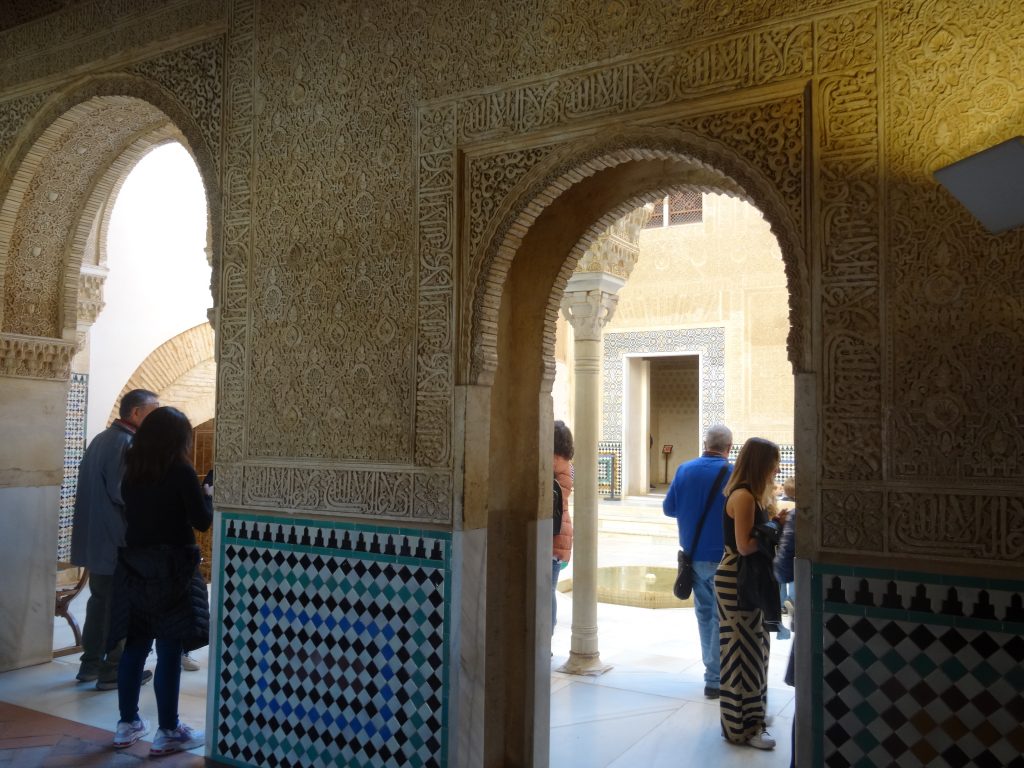
Inside the Alhambra 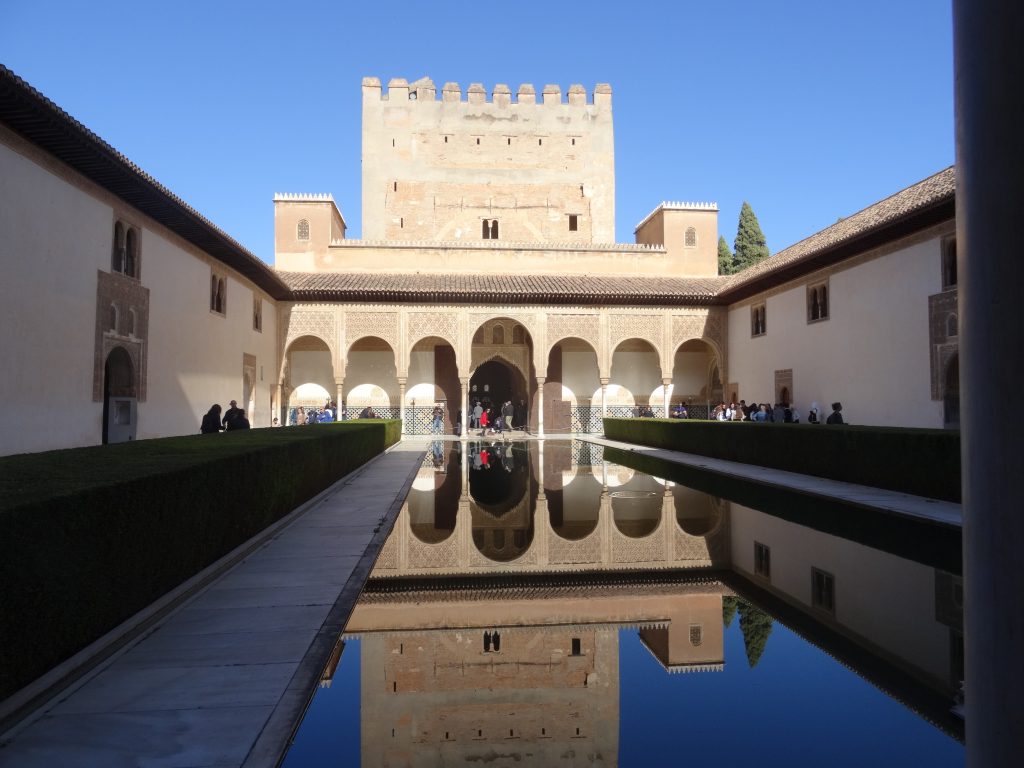
A reflecting pool 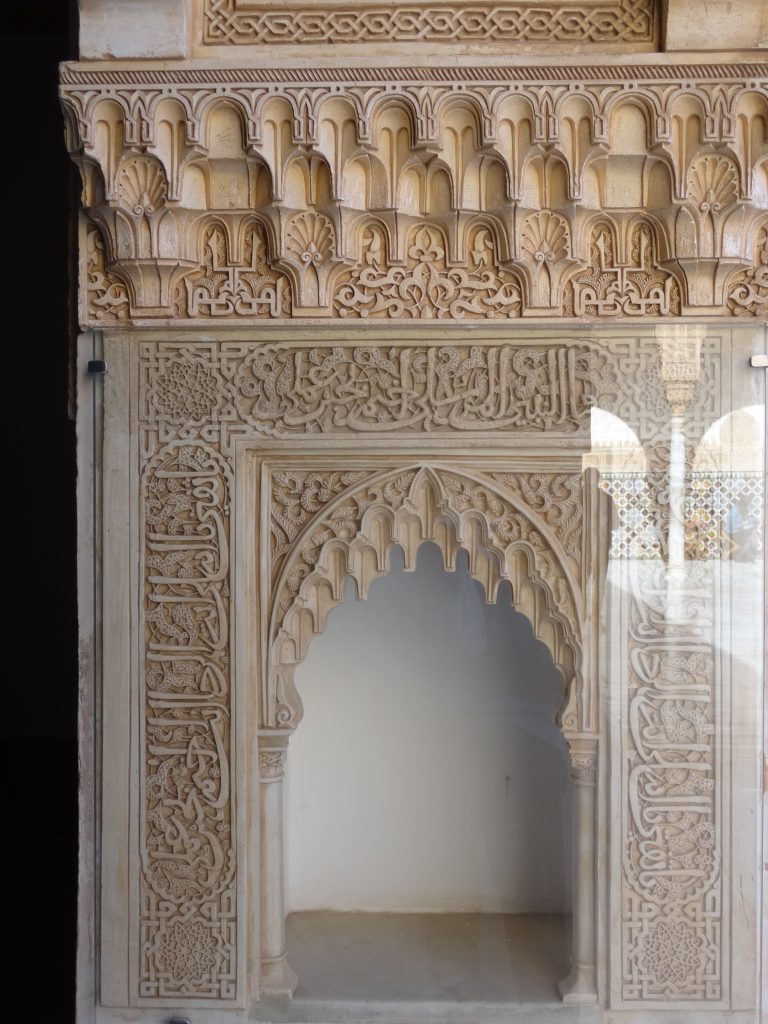
Carved doorway 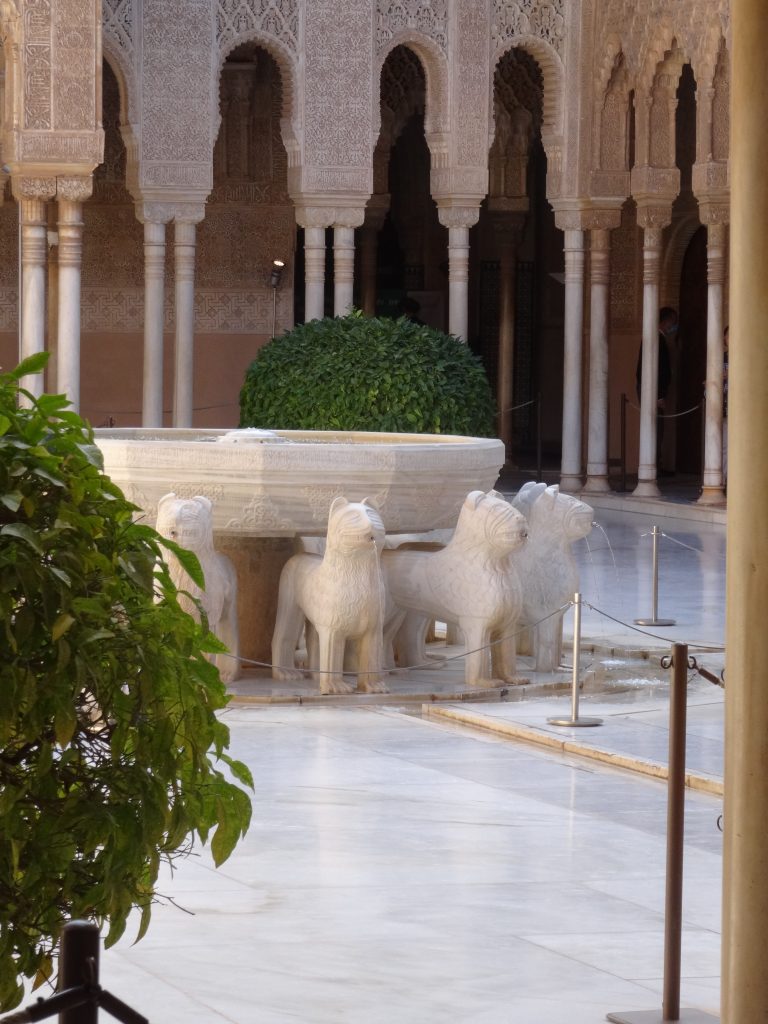
Lion fountain 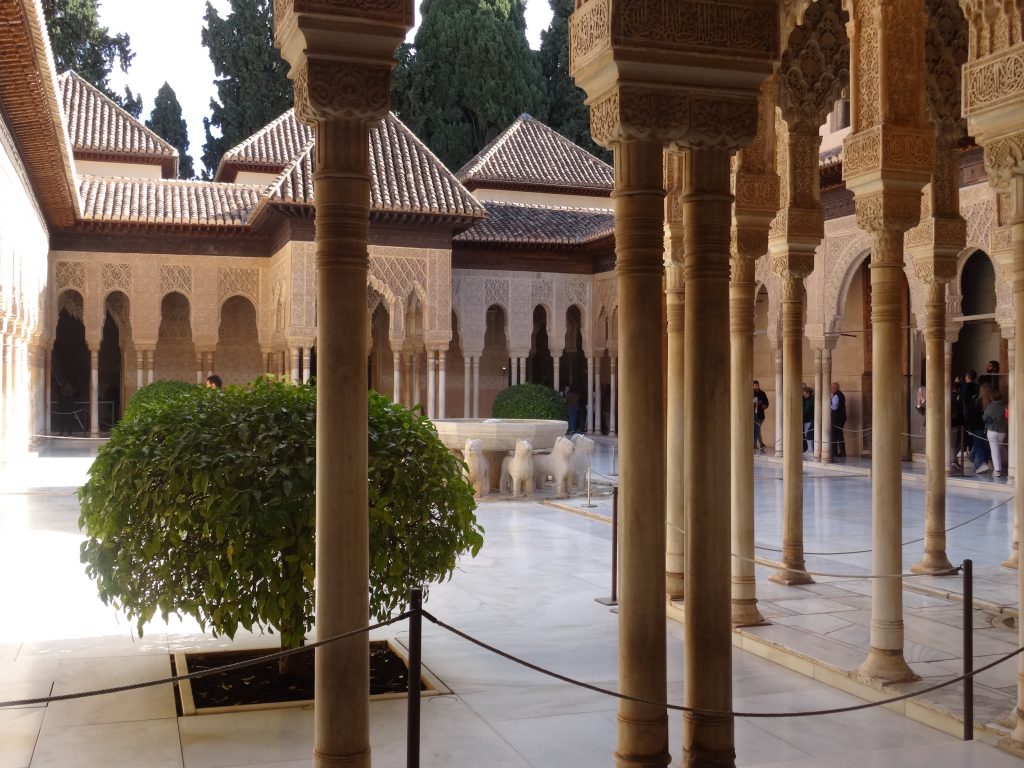
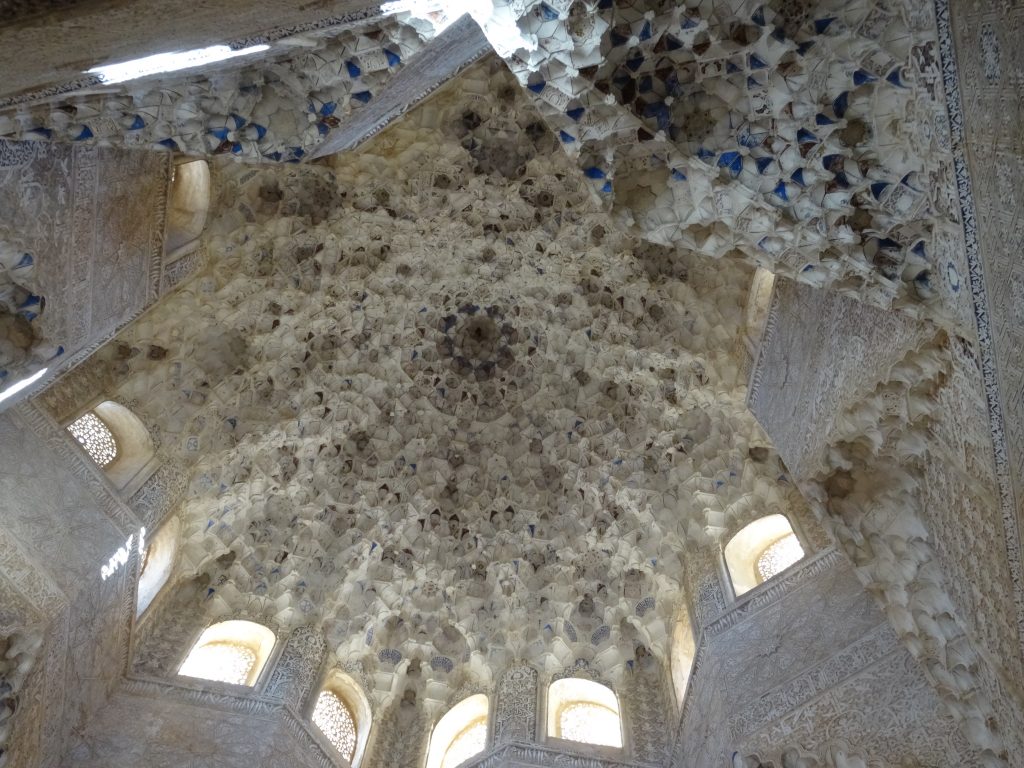
Intricate ceiling 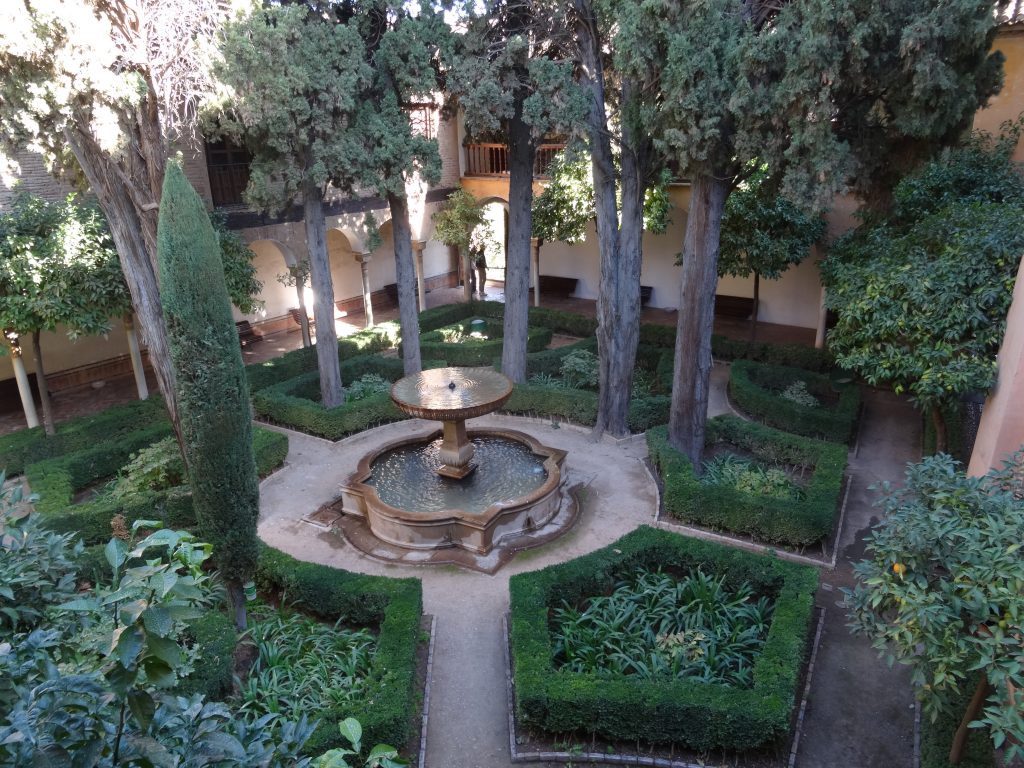
Green and tranquil courtyard 
Generalife Gardens 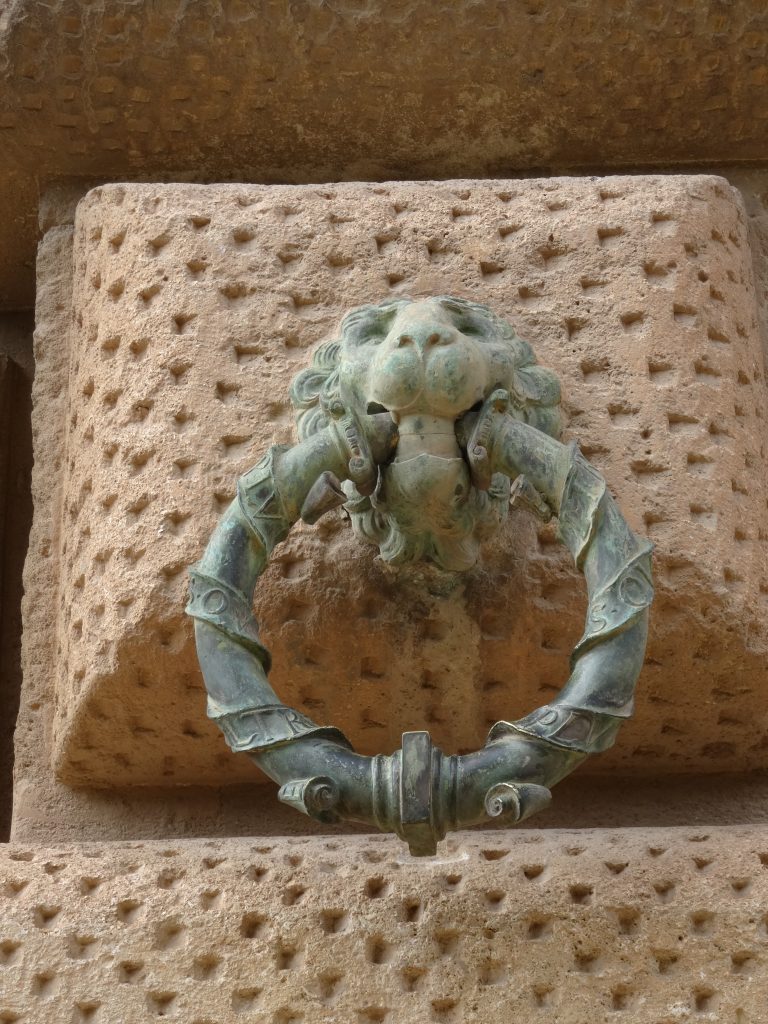
Lion door knocker? 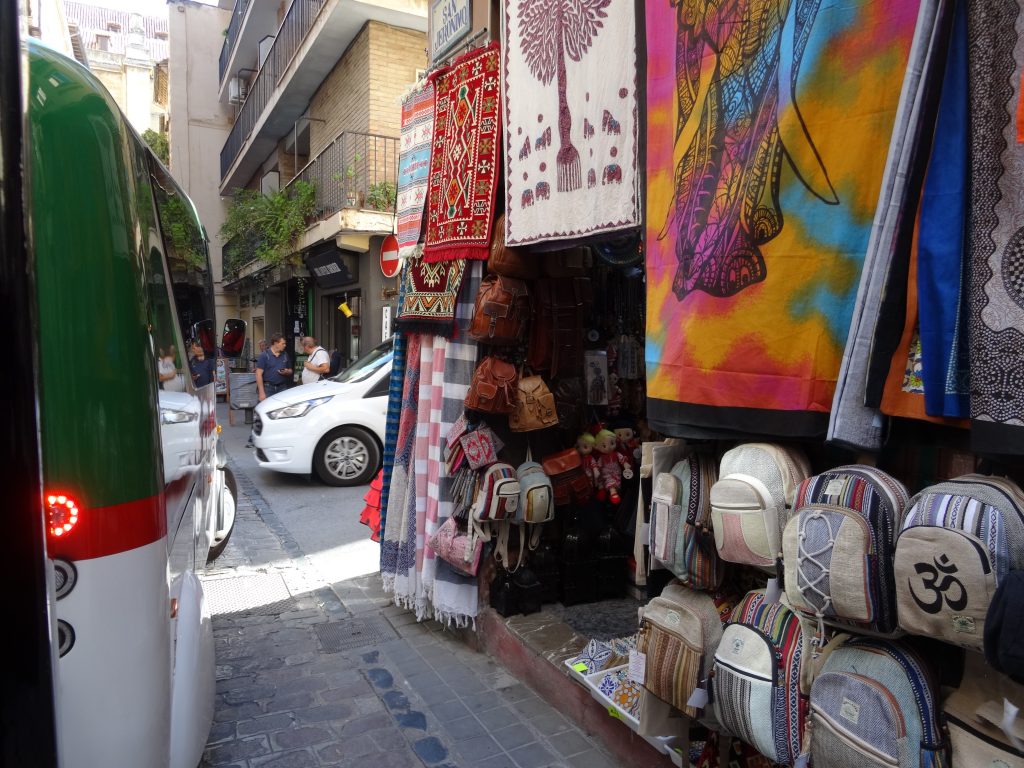
Hop on bus through town -
Granada – Cave House
The first 24 hours in Granada were … shall we say, interesting. Feeling somewhat adventuresome, we had booked a cave house. Now, who wouldn’t want to stay in a cave? Located high on a hillside, literally overlooking the Alhambra Palace … but we needed to get there first. Chandra (the owner) had given us detailed driving instructions as Google often sent prospective renters to the wrong area. Granada is NOT the easiest city to navigate. Traffic lights are not always located right at intersections … they can be beforehand … or around a curve in the road — causing Google to hesitate before giving turn instructions. The small hillside community of Sacromonte (where we’ll be staying) is on the east side of Granada, and is the traditional suburb of the Granada gypsies or gitanos. There are still flamenco shows held in the caves and restaurants, and people have been living in caves here for hundreds of years. One has to keep in mind that it closes twice a day to incoming traffic (not quite sure why) … 11am to 2pm and then again between 8pm and midnight, however vehicles can leave at any time. Presumably to limit the amount of traffic — especially as they do walking tours of the area – both day and night ones. Our arrival coincided with the 2:00 pm reopening and kids getting out of school, so we entered on a tidal wave of people, cars and tradesmen into the minuscule neighbourhood — a bit daunting when you don’t know where you’re going. After a series of phone calls to Chandra (most of which cut out after a few minutes – phone reception here is atrocious) we eventually found a parking space and hoped our car would still be there when we left.
We had been warned that suitcases would have to be left in the car and that we’d be walking up the hillside with only backpacks and things we could carry, so we took essentials and left the rest in the car. Then, working solely from pictures with arrows, we started our way up stairs, around corners, up slopes and more stairs … all the while avoiding a veritable carpet of dog droppings . By this point it had started to rain and the cobblestones became very slippery as we trudged ever upwards. We had to backtrack a couple of times, and ask for directions. More interrupted phone calls, and the enlistment of a neighbour’s son (who spoke no English). At last number 95 hove into view … now to get the key dropbox to work. It was small and up so high in the door frame that even Glen had to stand on tippy-toe to reach it. Six tries later, the keys were still securely inside and we stood damply outside. But then … Success at last … we were in.
Each cave is individual, with no set plan. Residents would have excavated additional rooms as necessary and interiors painted with many layers of whitewash to both seal the surface and make it brighter and lighter inside. Windows are along the outward facing wall – usually kitchen, living room while the rest of the house extends underground. Temperature inside stays pretty constant throughout the year … nice in summer, but probably pretty cold in winter. There are portable heaters now, but electricity is limited and you can only run one power hungry appliance at a time. Floors are usually tiled and a little uneven, so furniture can be a trifle wonky at times. Wall recesses act as storage or shelves and there can be a step or two between varying levels. Understandably these are compact and quirky abodes, but that just adds to the overall charm. And what an experience! I don’t imagine it was easy to wire a cave house for electricity or internet … but you certainly couldn’t hear the neighbours! This link gives a great tour of cave houses. https://www.thewildlifediaries.com/sacromonte-caves-granada/
The area seems to be a mix of mostly long term residents but with a certain ‘hippy’ vibe in places. Walking through on our way to town that evening we encountered several of the evening walking tours as they clattered up and down the steep lanes, or took photos of the Alhambra lit up at night (it is an amazing sight).
In “our” cave, the living room and bedrooms were comfortable and authentically decorated. However, the kitchen, bathroom and outside patio were decidedly less so. I don’t think we’re picky or hard to please … small, compact and quirky is great … what’s NOT acceptable, though, is lack of cleanliness … and certainly not for the prices charged. This was the 2nd most expensive of the entire trip. The bathroom consisted of a toilet and crudely tiled shower area, no glass in the window – just a wooden shutter (the light worked, sometimes) and mouldy walls. It was freezing in there – especially for nighttime visits! The sink was in the entry way and badly cracked. In the kitchen things were not much better … greasy residue on cutlery, plates and mugs … cracked knife handles … broken utensils … stale food items from previous renters.
The dustpan was beyond redemption – the dust just fell through the cracks. The patio also fell short of the lovely photos portraying an arbor-covered eating and sitting area with spectacular views of the Alhambra Palace virtually within touching distance. The views were there alright … but nobody had cleared the area of the decaying grapes which smothered every surface. And the artificial turf underfoot, which was obviously the haunt of every neighbourhood cat, made sitting and enjoying the views most unpleasant. I’m afraid one night was enough of cave dwelling – we found a very nice apartment in town. Not the views … but at least bums didn’t freeze to toilet seats at night! This place could have been exceptional … all it needed was a little care and cleanliness. Sacromonto is a delightfully picturesque village with lovely and sometimes quirky houses everywhere. One house apparently has so many photos taken, that owners have put up a table outside demanding payment!
As I mentioned, Granada is NOT the easiest place to navigate. And parking is a nightmare, especially when multiple ticket machines don’t function … leaving people aimlessly punching buttons and hoping something works. Parking attendants just shrug … or hide! We eventually found a place and went exploring – our apartment wouldn’t be ready till later. The sun was out, but up here in the mountains it was still a touch chilly … so we found a sunny cafe and had lunch.
The apartment was luxurious by comparison – especially the bathroom! That evening we found a nearby taverna … a real mix of clientelle. Groups of younger professionals … older men gathering over beer to put the world to rights, or watch the football game between Cadiz and Madrid … groups of women of all ages, sipping wine or beer as they chatted. Everyone seemed to know everyone else. There was lots of cheek kisses, hugs and back slapping. It was a comfortable, noisy, fun place. The basket of mixed fried seafood went down well, too. Tiny, crispy herrings you popped into your mouth whole and scrunched up … prawns … squid … and chunks of (we think) deep fried dog fish. It had that chewy, slightly ‘sour’ flavour. Can’t say I’m a fan, but it was fresh, and the rest was delicious. The beer came with a free tapa too. Granada is (apparently) the last major city in Spain offering free tapas with the beer.
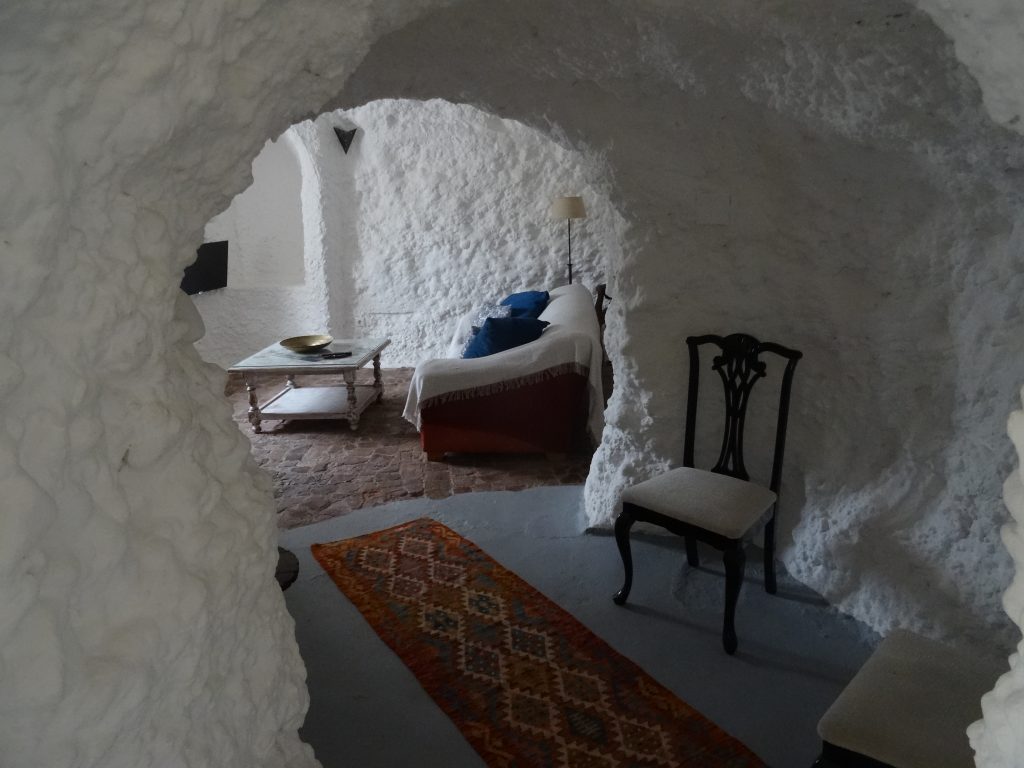
Hall and Living room, Cave House 
Bedroom 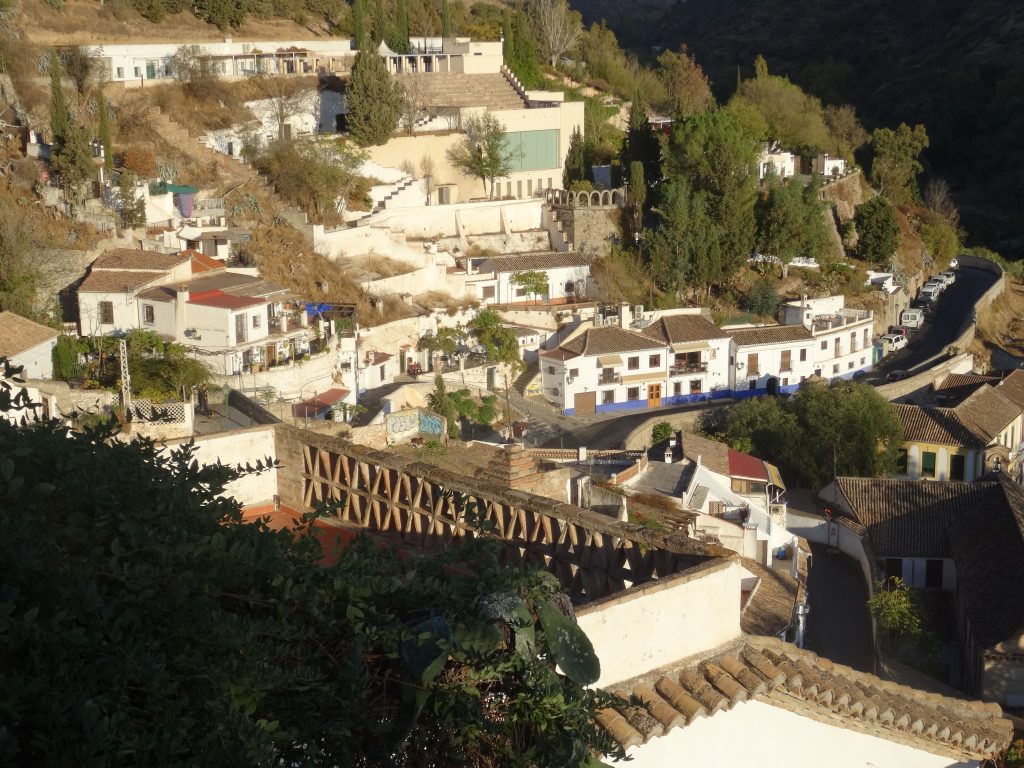
View down at other cave houses 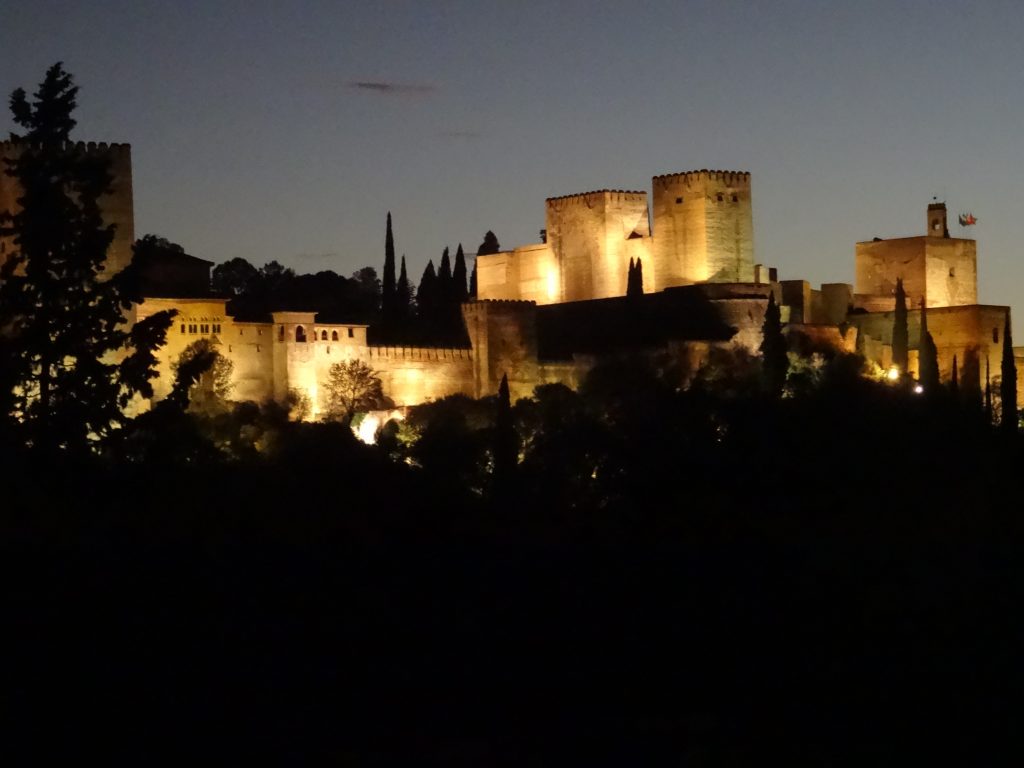
Alhambra at night 
Early morning view of the Alhambra from the cave house 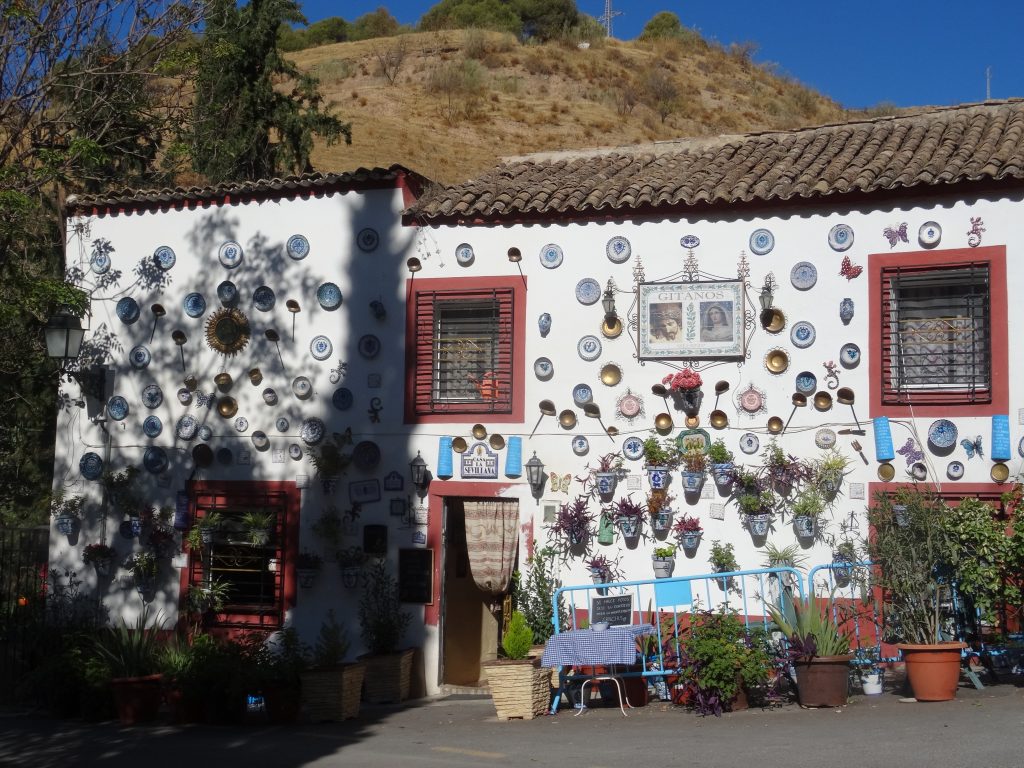
House in Sacromonto covered with plates 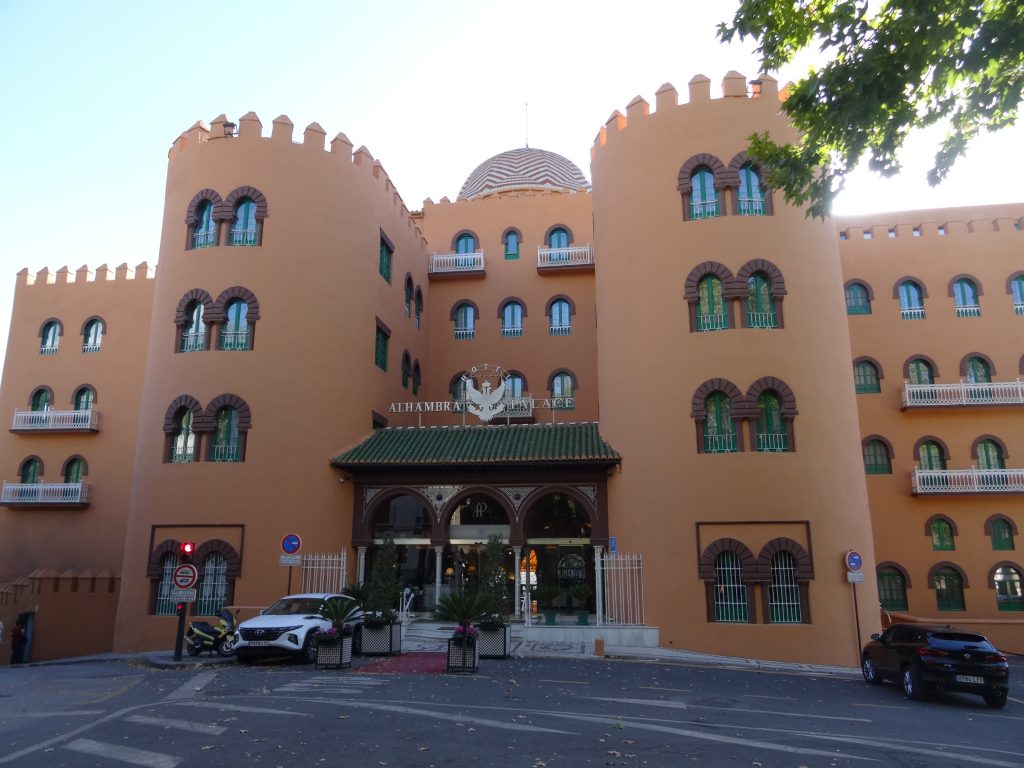
The Alhambra Hotel hasn’t changed a scrap in 60 years! -
Sand Dunes and Tapas
Thinking we could stop for a coffee and croissant before taking the ferry back to Tarifa, we packed up early and made for the elevator (we were on the 9th floor). The key fob sensor that had to be used to go up … was also needed to punch in the number for going down. The door began to close … then stopped just a couple of inches shy of shutting. We tried again. Nope. After ten or so tries, we gave up and looked around for the stairs. Um, where are they? There were two other apartments on this floor, and two unmarked wooden doors with no handles. A tentative push of the nearest one — aha – we have stairs. Met the apartment manager on his way up in search of the problem.
It’s a 25 minute walk to the ferry terminal so no time to stop for coffee. We’ve thoroughly enjoyed our time here — the only thing we won’t miss are the hair-raising road crossings … the red and white striped markings don’t help in the least!
The voyage back to Tarifa was delightful. No passport control line-ups, there are comfy seats, great views and good coffee.
I was curious to see how the area between Gibraltar and Estepona had changed over the years … it won’t be the sleepy fishing village any more. Surprisingly, there’s a stretch of shoreline near the town of Milneva, just south of Estapona, which is relatively untouched by the Costa del Sol tourism machine. A quiet beach with natural walking trails, an eco-reserve for wildlife and plants … just the sound of gentle waves with distant views of Estepona around the curve of the bay.
Feeling hungry, there happened to be a Burger King handy … not our first choice of food establishment, but it was close by. Yikes, the prices! Nine euros for a mediocre burger … I think not! We drove on and found a quiet corner bar and ordered tapas and a small beer each. And what tapas they were too! Four to start with … meatballs in a tangy tomato sauce … pulpo (octopus) salad with finely diced potatoes and onions … spicy gambas (prawns), and slices of beef and mushrooms in a creamy roquefort sauce. All came with a crusty slice of bread and petite forks … and all were delicious — but the octopus and beef were outstanding. We went back for seconds of those two and added a lobster salad as well. The perfect amount, and the total (including beer) came to less than two burgers! Absolutely no contest!
One excursion in Tarifa I forgot to mention, were the sand dunes — at Punta Paloma https://www.youtube.com/watch?v=e0nnn46KTFY
We took our shoes off and struggled up the dune beside the road, sinking into the fine white sand and reaching the top, stood mesmerized. There before us lay the entire bay all the way to Tarifa with Jebel Mousa (mountain in Morocco) in the background. Deep blue water, a wide rim of pale sand … and dozens and dozens and dozens of windsurfers and kite surfers racing back and forth across the water, leaving trails of white behind them. We sat on a warm sandy hillock and just watched the ever-changing spectacle — like a living kaleidoscope. The sails used by some of these windsurfers are quite different — not attached to the board at all, but held up like a pair of wings and tilted one way or the other. Then, in order to build up speed after a dunking, the windsurfer would bob up and down – almost like a character in the old cartoons.
In some places, the natural twig/bamboo fences used years ago along the dune ridges — to stop sand from blowing and moving about – have become a hazard. The dunes have shifted — covering up most of the fences and leaving only the sharp, foot-stabbing tops, barely visible … and sometimes, not even that.
A family on horseback rode down to the firmer sand along the water’s edge … Mum and Dad in the lead … teenage daughter behind … on her cell phone!
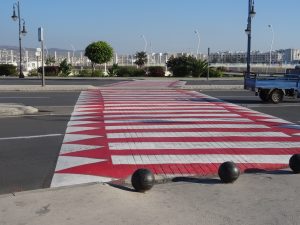
Pedestrian crossing in Tangier 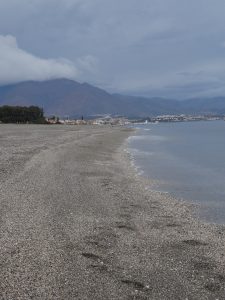
There’s still a beach as I remember it, near Estepona 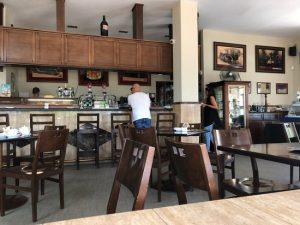
Tapas Bar, Estepona 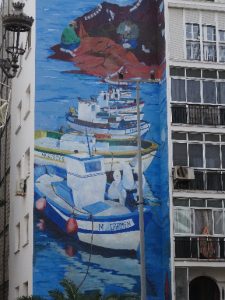
Wall mural, Estepona 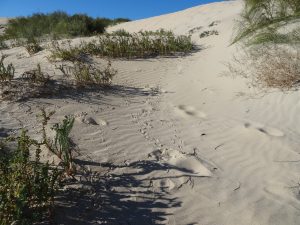
Sand Dunes 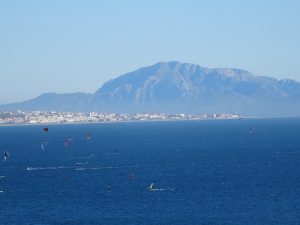
Wind Surfers with Jebel Musa (N. Africa) in behind 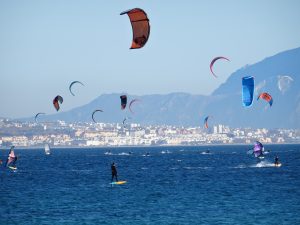
Wind and Kite surfer – Kaleidoscope 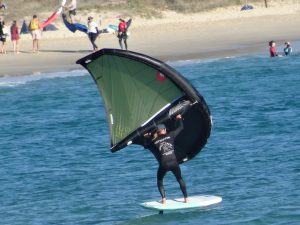
New type of windsurfer 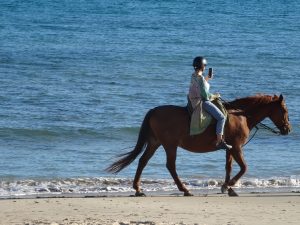
Even on horseback … a phone -
Tangier – Ouds, Tea and Minarets
The dawn calling to prayer (Imsak)– around 6:15 a.m. at present — is nowadays broadcast by amplified speakers from the tallest Minarets. You can hear echoing calls from all over the city … quite a haunting sound first thing in the morning and at nightfall (Isha) … there are three others throughout the day, but city noise tends to blur them). Apparently there’s an app you can install on your phone to keep track of the times as these will change depending on the time of year.
Breakfast at Le Boulevard … a boulangerie et patisserie. Superb coffee … and mushroom, spinach & cheese omelet with fresh (still warm) round grainy breads … you see them everywhere being delivered. Their counters groaning with breads, pastries, croissants, cakes, and macaroons. One man went out with SIX French breads under his arm. Afterwards, a stroll along the waterfront then up into the Petite Souk … where the locals shop. Almost a shanty town of stalls, jammed together … fruits and vegetables … live chickens in cages, awaiting their fate … handicrafts … nick-knacks … shoes and handbags. Counters of nose-tickling spices … vats of multi-coloured pickled olives … shelves of medicinal herbs and cures. Further along the fish market — floors constantly sluiced with water, merchants in rubber boots … fish of every shape, size and species. The meat market was a little less appetizing … some of the stalls had various offal draped unappealingly from hooks, and rows of blackened sheep’s heads which stared at you with eye-less sockets … there was a pungent odour of putrefaction filtering through. Yesterday, in the more tourist area, it was impossible to walk more than a couple of feet without being coaxed into shops or offered tours … but here we just got curious looks as people went about their business. We ducked under a canvas roof into a dimly-lit maize of narrow walkways and cramped counters bursting with fresh produce … huge, yellow grapefruit with leaves still attached … earthy potatoes and yams … olives, nuts and spices … the stall owners hunched at the back, staring in disbelief. This was locals only territory! However a cheery Bonjour always brought a courteously rumbled Ca va in reply.
On our previous visit to the Kasbah with Mohammed, it hadn’t been possible to take all the photos I’d wanted as we were listening to his talk. Today, with deep blue skies and a slower pace, the photo opportunities were endless … as you can see! One small shop, tucked far away from all the rest, had a delightfully eclectic selection of goods for sale … jewelry, postcards, leather pouches, books, antique cameras, pottery, wooden figurines. While I browsed the earrings, Glen had the pleasure of chatting with the owner … no high pressure sales. It seems this lane and archway was favoured by the artist Matisse . . . and there were postcards of the painting to prove it.
Further on, the melodic sounds of an Oud drifted out a window. Here was an accomplished player … and the music had a decided Andalucian/Moroccan fusion. A tiny shop offering mint tea and music — we were waved to come and sit a while. The walls were completely covered with colourful blankets, pictures and assorted Ouds. We sat and chatted, got to look at and ‘play’ an Oud and drums. There are 10 strings — 4 pairs and 2 individual with higher tones – producing a beautiful harmony. We sat outside on brightly padded tiny stools and listened as we drank our mint tea.
Taking a wrong turn (despite Miss Google), a polite young fellow of about 8 or 9 was quite insistent that this lane was ferme, and shot off in front of us to lead the way. It was only one street away .. he introduced himself as Hamza and he never once asked for any cash . .. just sat on a nearby wall and smiled. He raced off with a big grin clutching a few coins of loose change as payment.
We had tea on the terrace at the Hotel Continental! Built right into the clifftop with a commanding view over Tangier’s harbour front and a guest list of the world’s Who’s Who as long as your arm. But it’s the inside that leaves you gob-smacked. Every wall, ceiling and floor is intricately tiled — some painted, other’s look like fine paper quill work. There are Moorish doors and windows . . . stained glass windows splashing colour across the floors … individual alcoves with lounging beds, fountains and heavyily tasseled curtains for privacy (quite decadent) … gigantic silver tea urns . . . leather camel saddles. Truly a remarkable sight. It was mid afternoon and we had the entire place to ourselves, it was only as we were about to leave that a few other people arrived.
Walking along the waterfront we’d hoped to go into the fishing port … but it was securely behind fencing and barbed wire. Shame, because the boats were so colourful. We waded our way through a sea of restaurant scouts, all desperately trying to drum up business. They must’ve been hurting as a result of Covid … but goodness, they were tenacious! We sat on the sea wall instead and watched men long line fishing from the rocks below. How did they get down there?
It’s quite a way. A young man provided the answer … he piled up rocks against the sea wall, and with the help of his two girlfriends above, clambered up. He got lots of cheers.
Not particularly hungry, and tired from a long day’s walking, we picked up some cakes and croissants from a nearby bakery (no idea what’s in them – everything was in Arabic) … fresh clementines from the fruit shop next door — still with their leaves, and returned to the apartment to indulge.
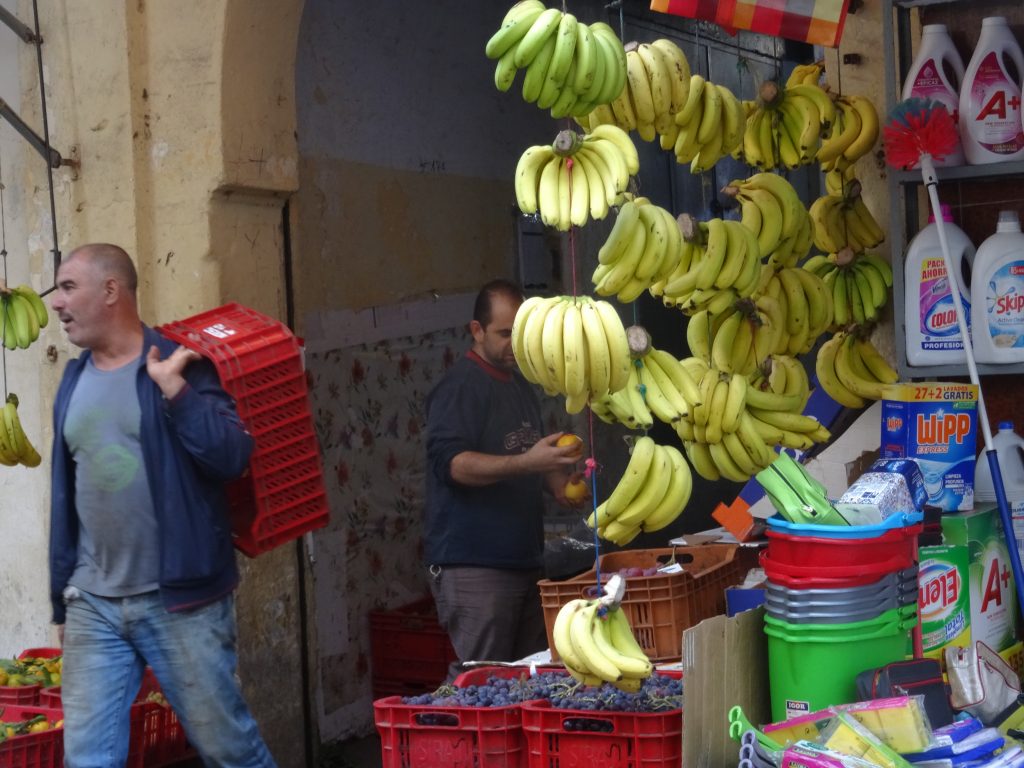
Petite Souk 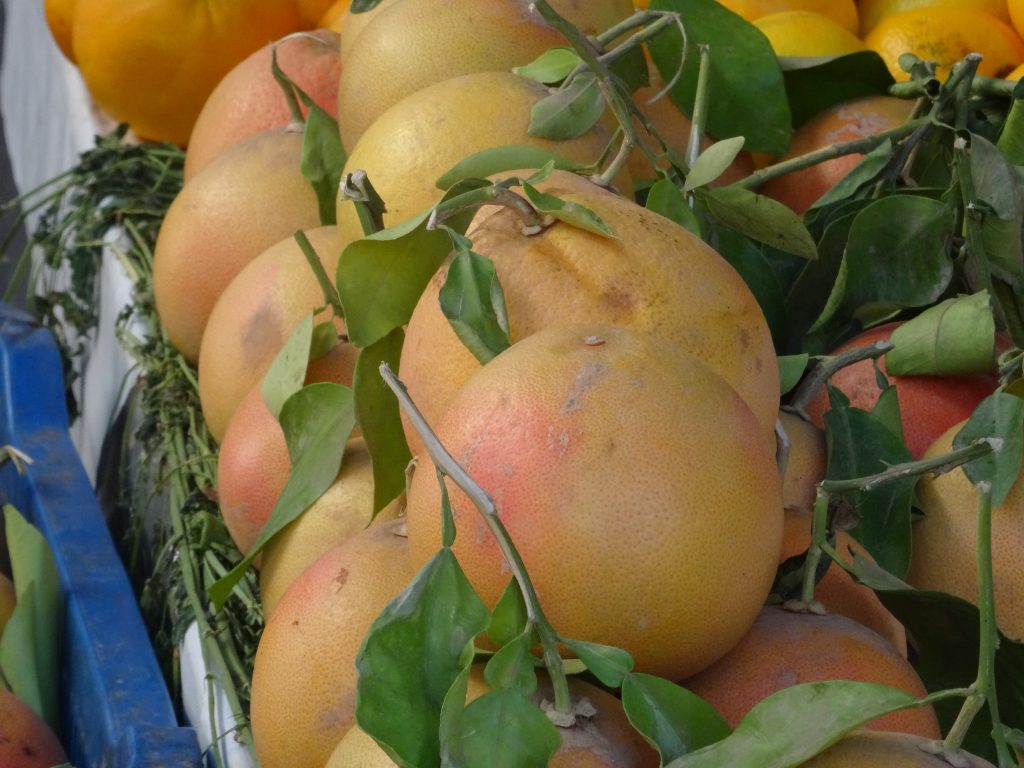
Fresh Grapefruit 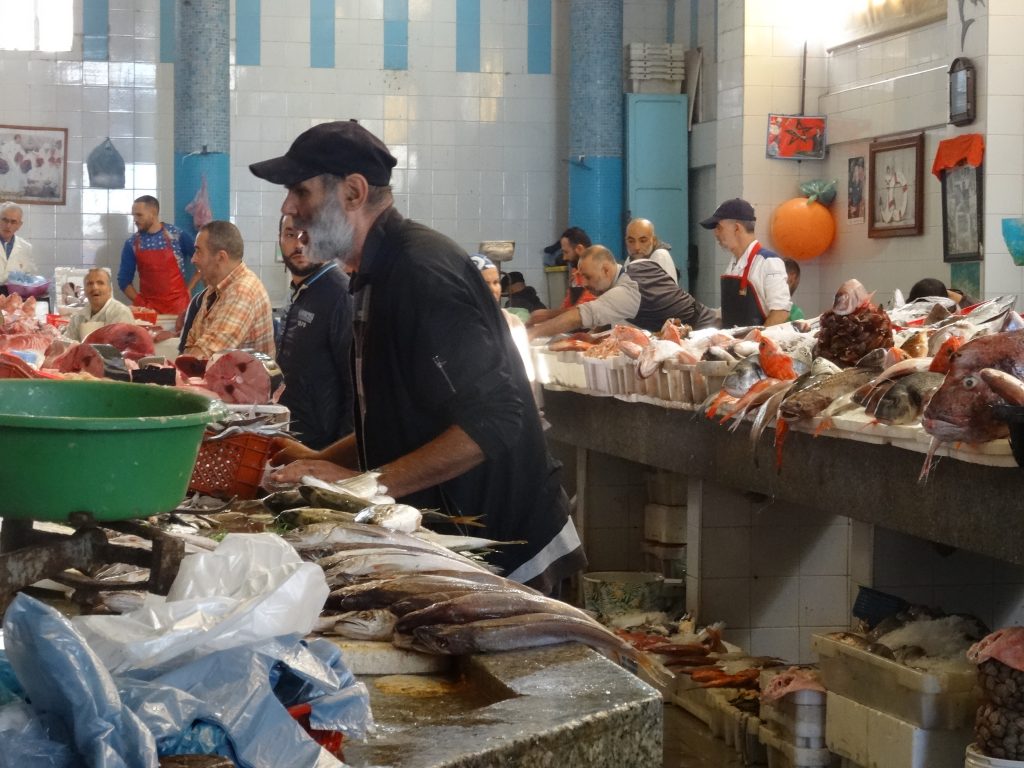
Fish of every description (and then some) 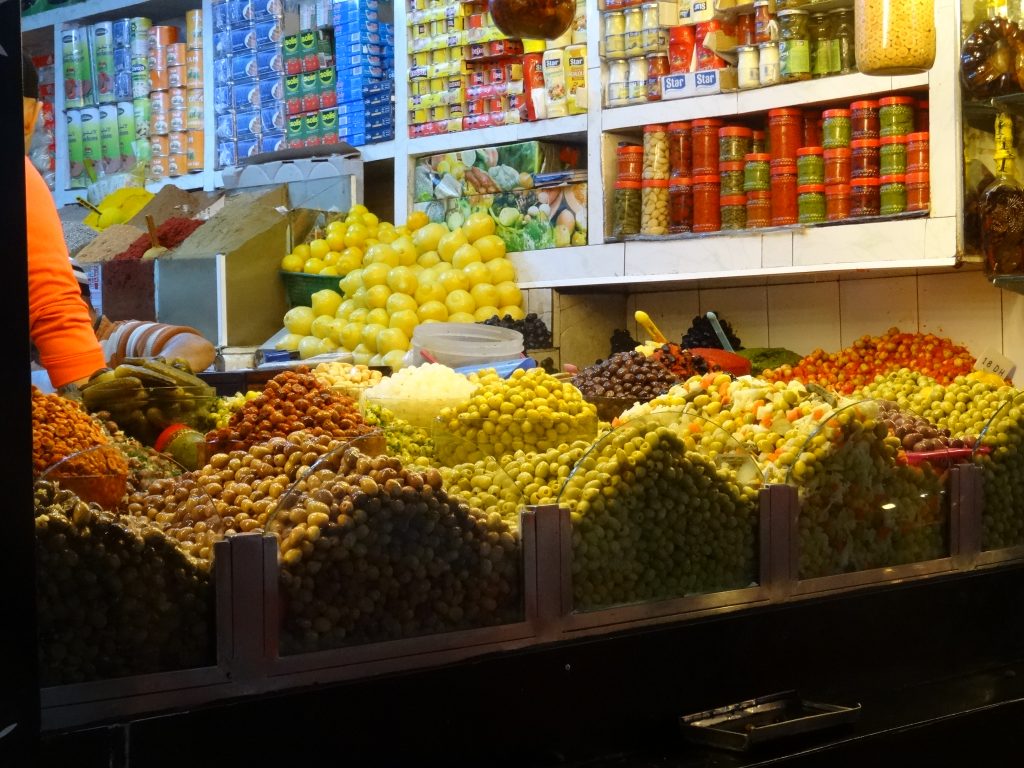
Olive counter 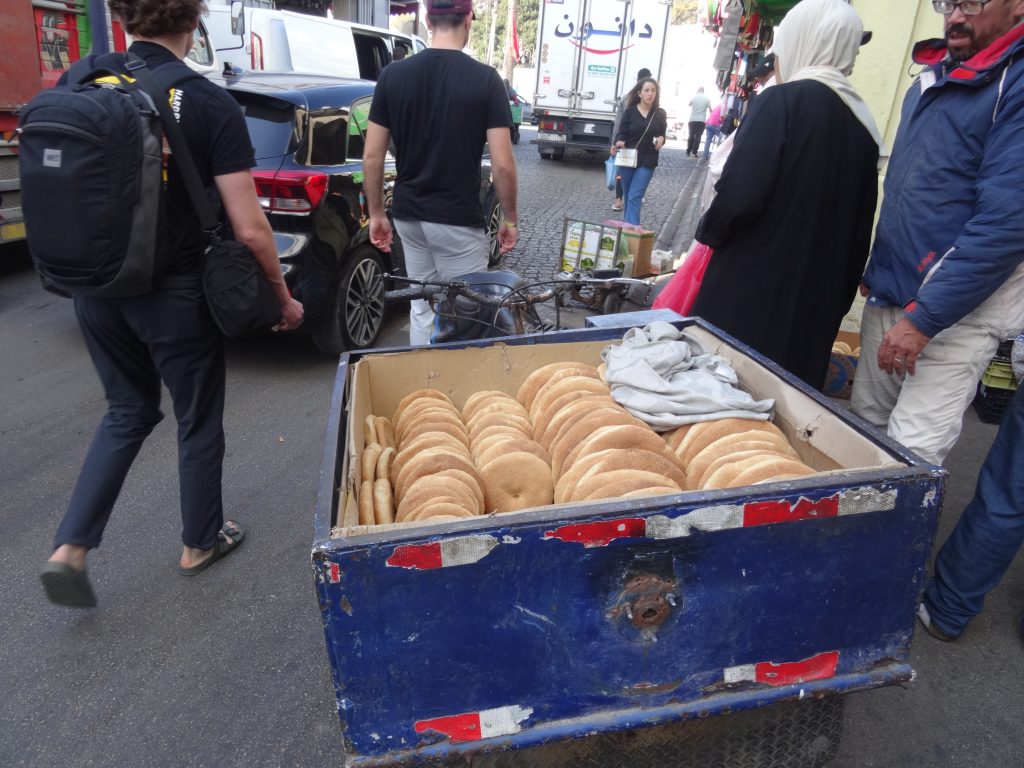
Bread deliver carts are everywhere 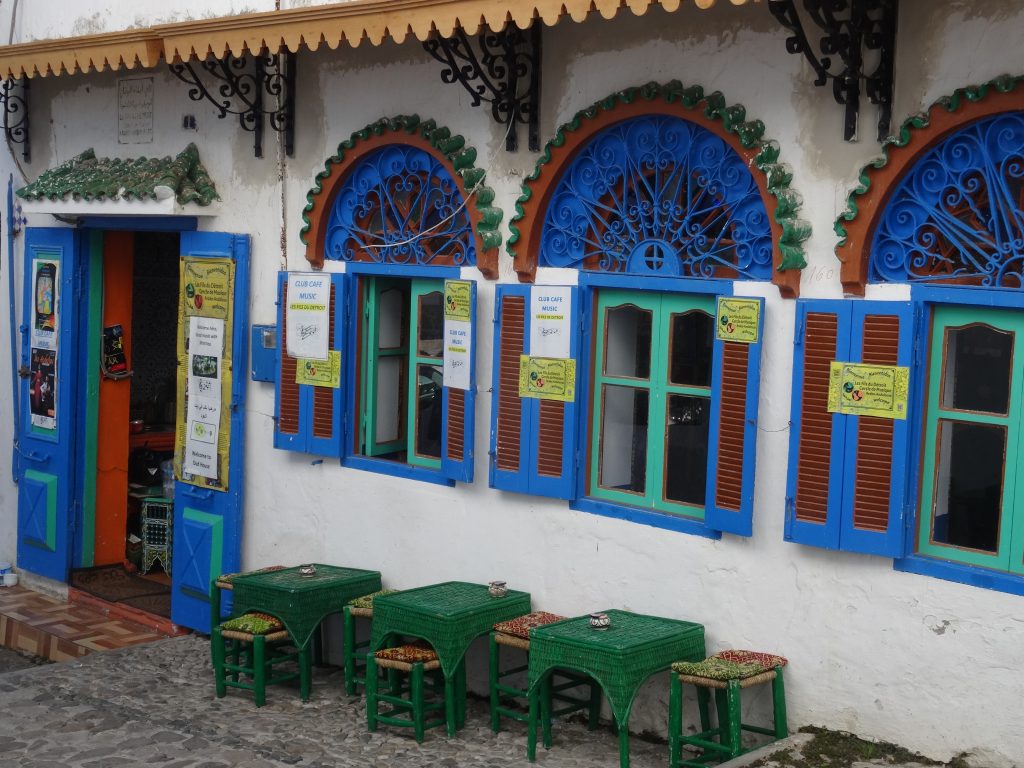
Tea shop with stools outside 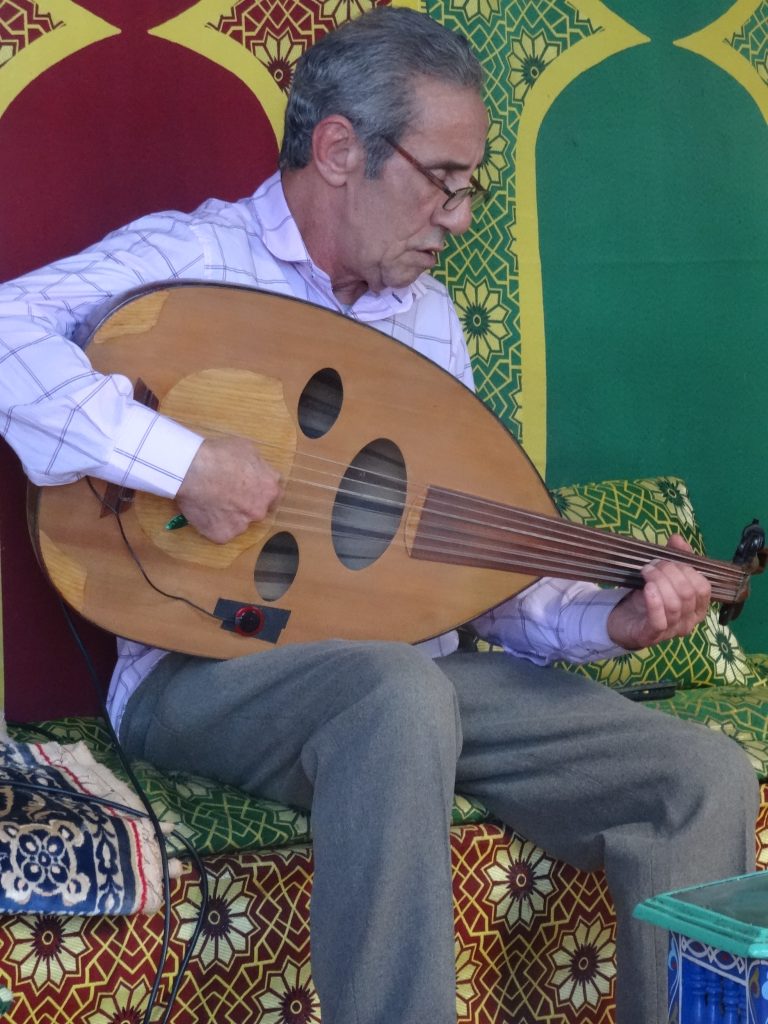
Teashop owner … and Oud Player 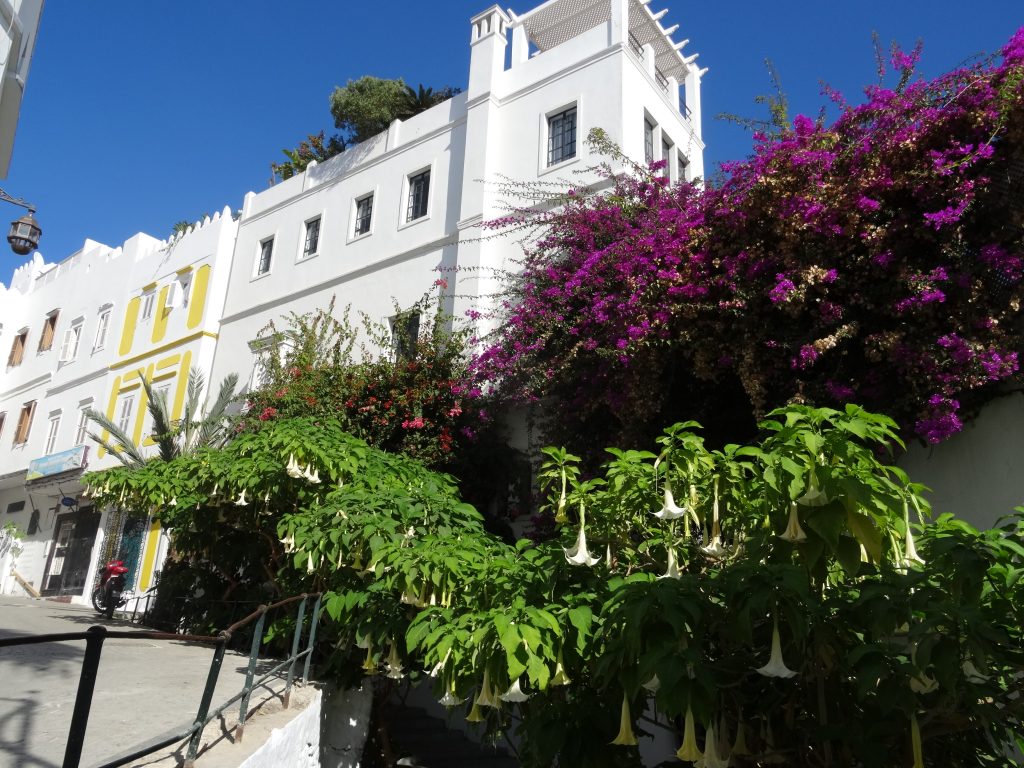
Angel Trumpet and Bougainvillia 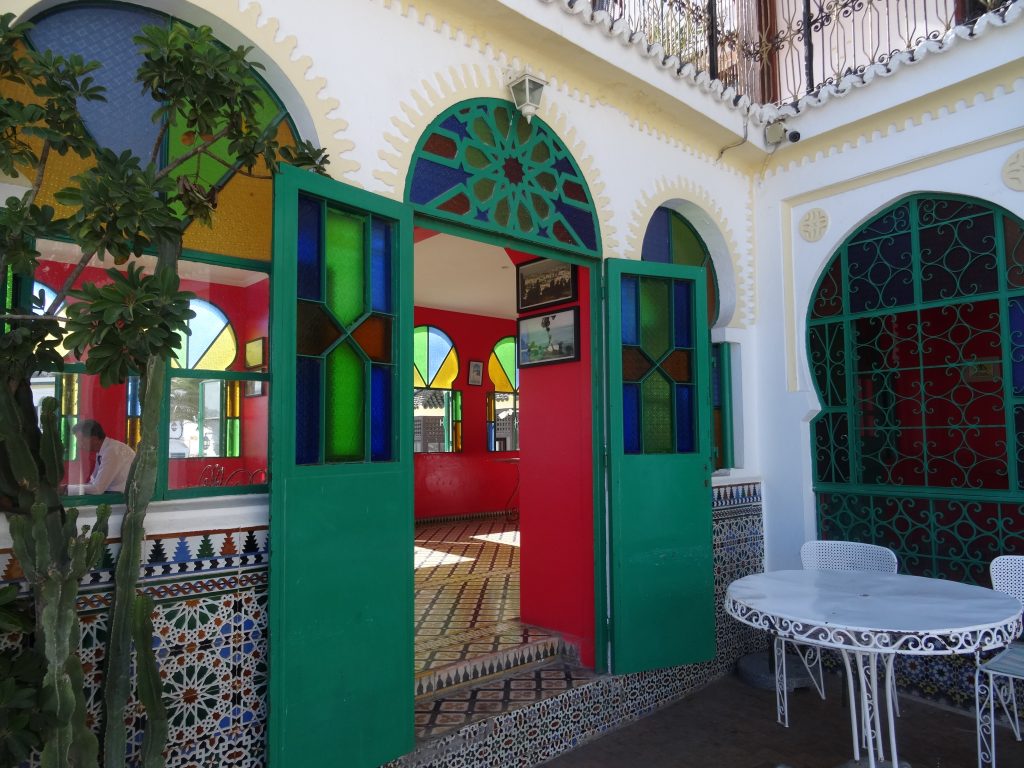
Continental Hotel 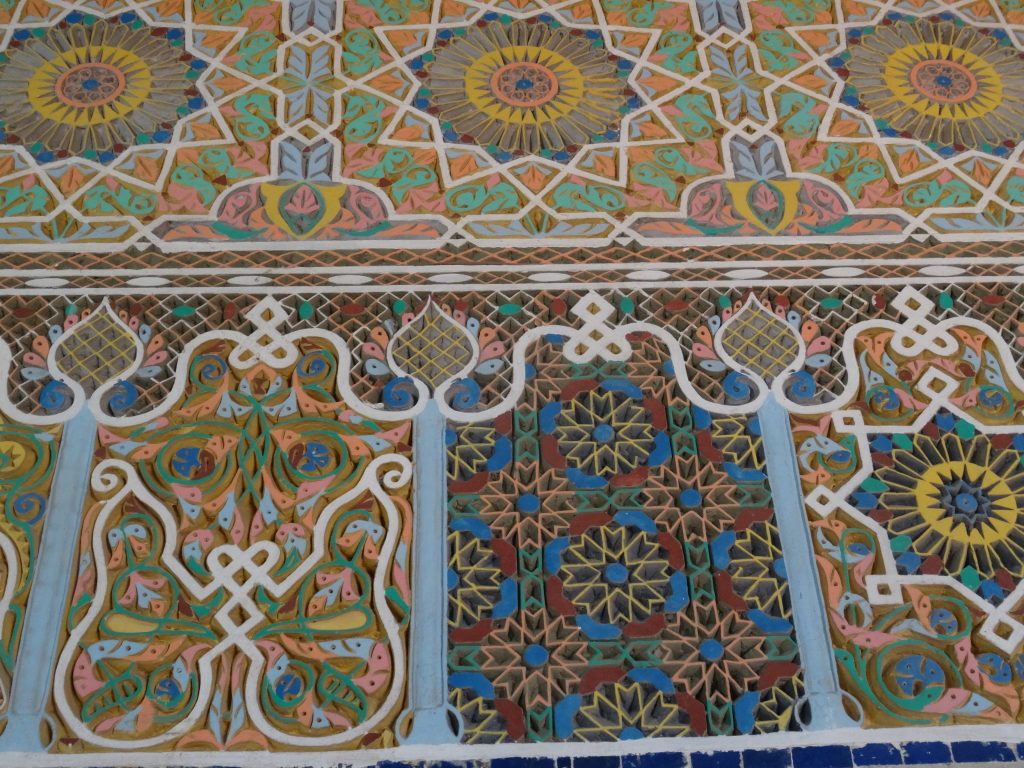
Just some of the tiles at the Continental Hotel 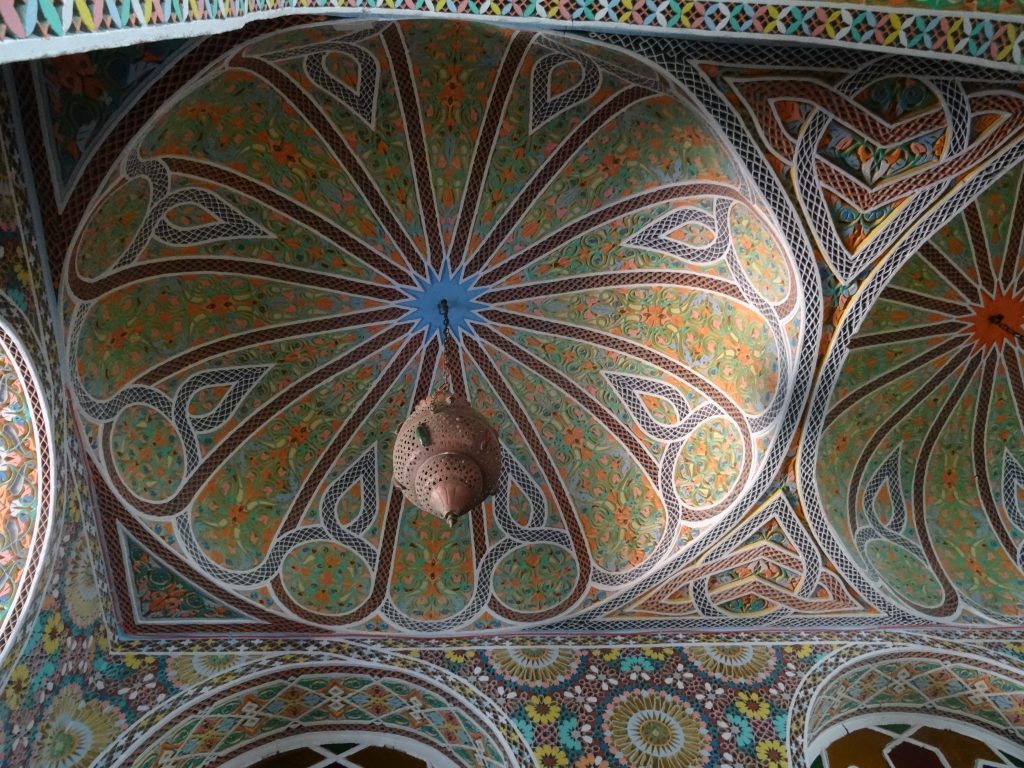
Gorgeous decorated ceiling 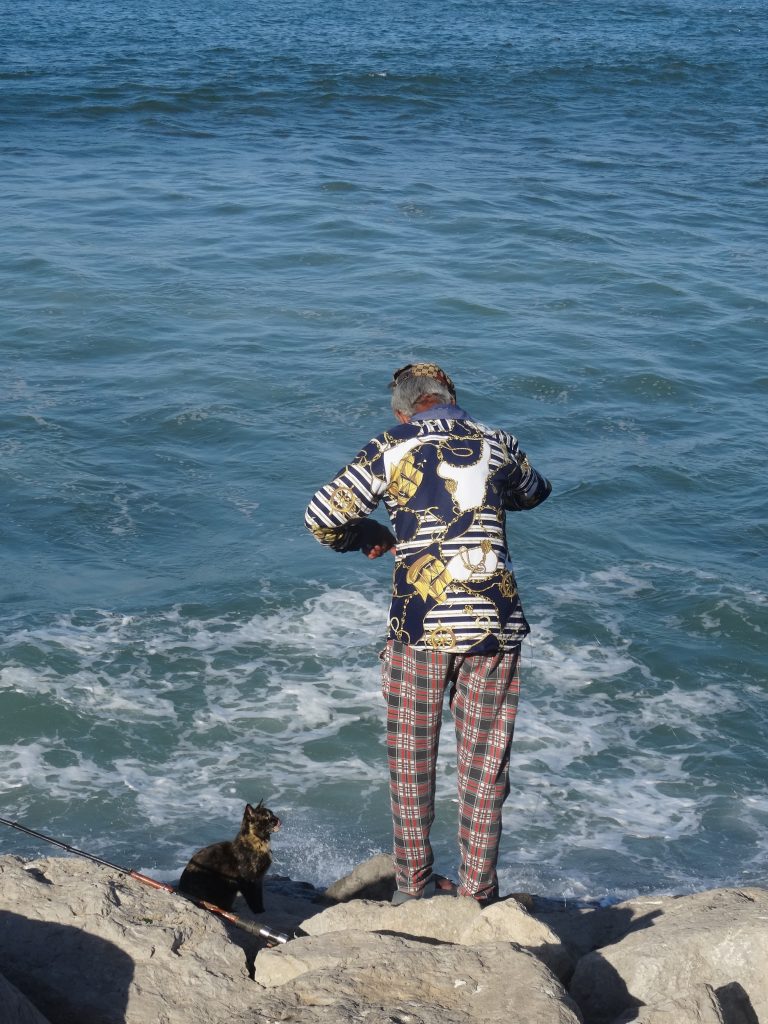
Local fisherman with just ONE of the million or so cats 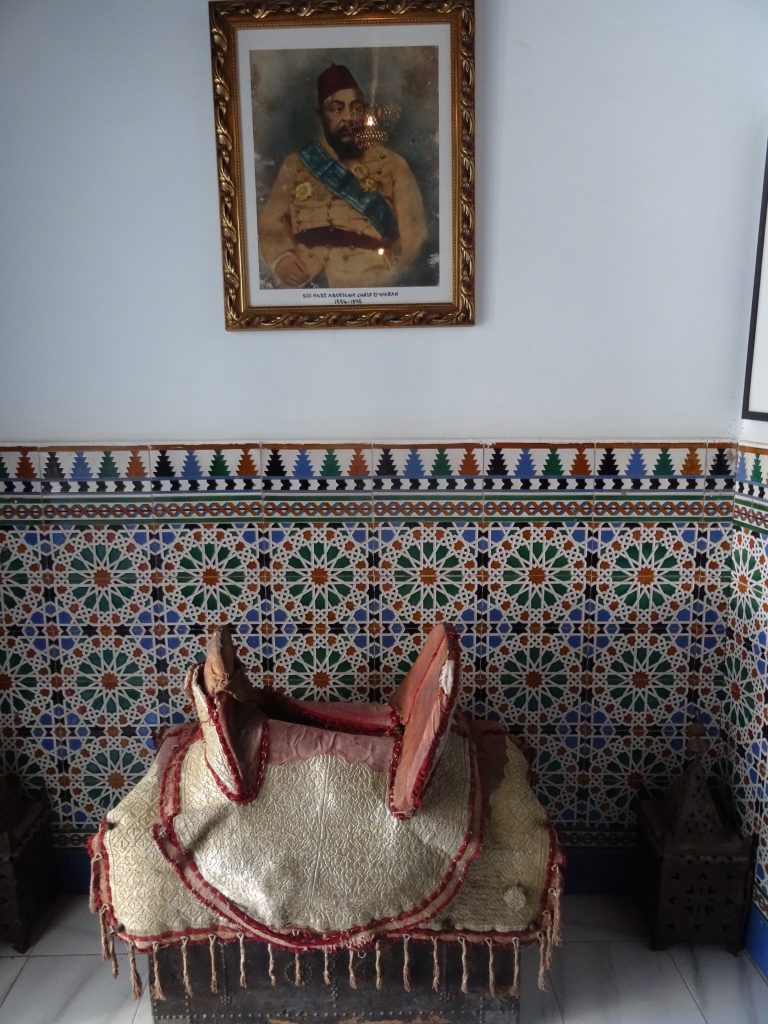
Camel Saddle 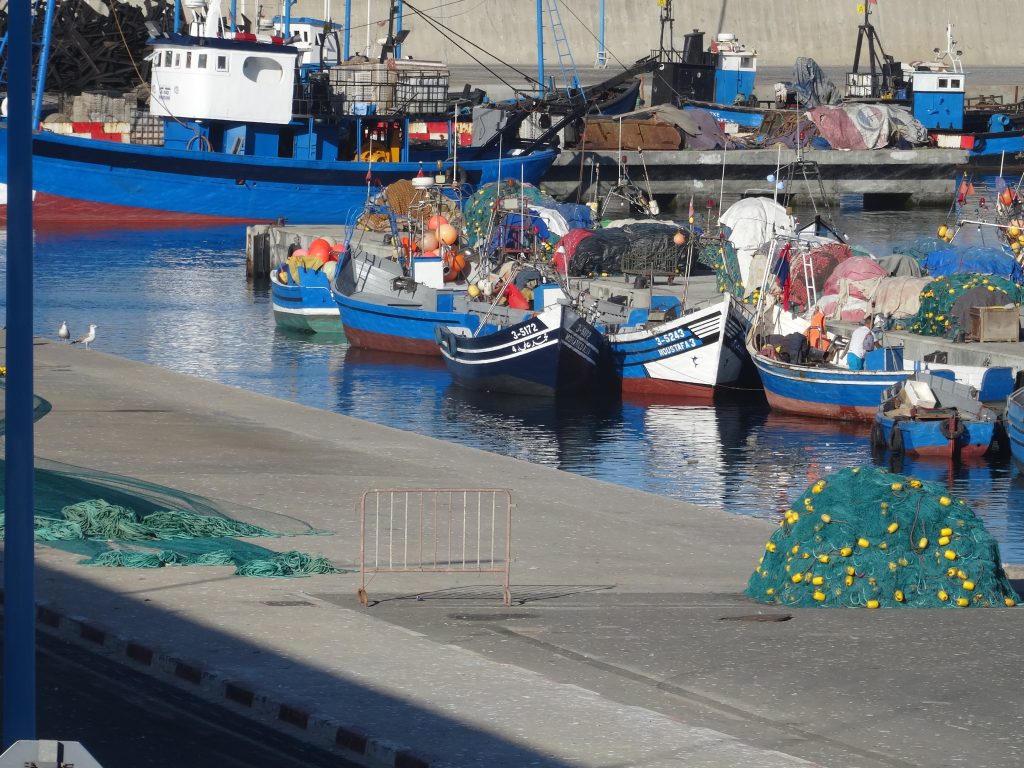
Fish boats and nets 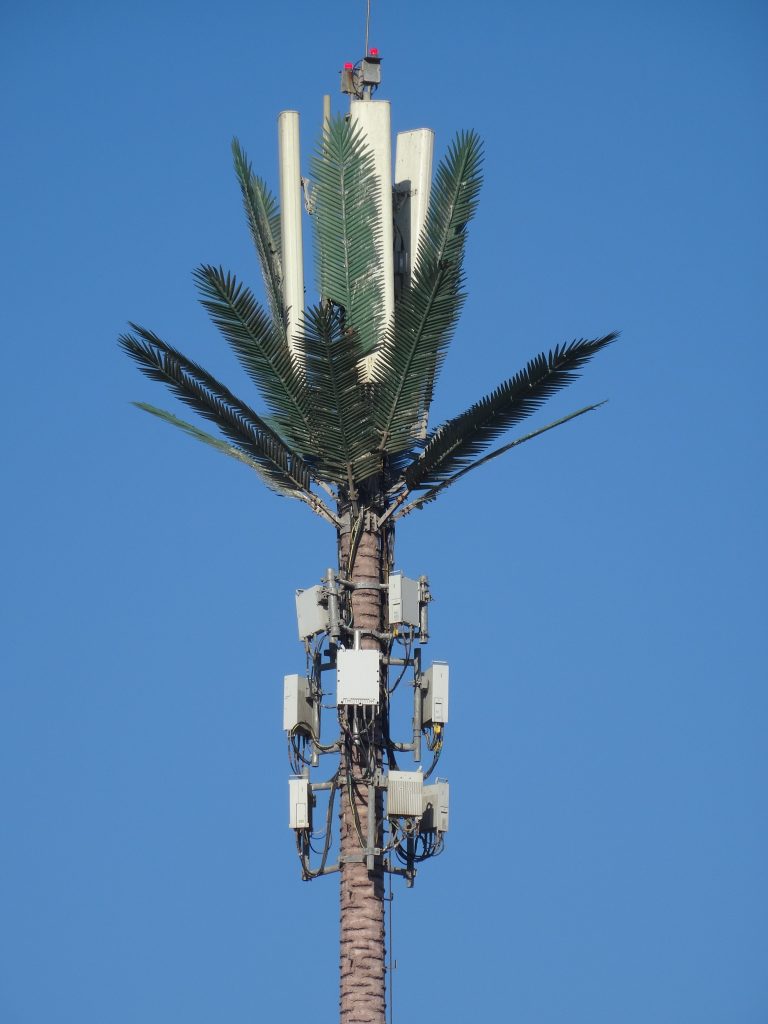
Cleverly disguised microwave tower -
And now for something completely different — Tangier
We’re this close, we HAVE to visit! As the Tarifa owner kindly let us leave our bags behind at the apartment and stay an additional night on our return, we can just take backpacks. There was absolutely no available parking down by the ferry terminal but a quiet street close by had just the spot. The FRS ticket office was on the way, so we popped in and a cheerful and helpful lady printed out our internet tickets and even filled out the Moroccan health and safety forms for us … we just have to adjust to speaking French now!
On board, all organization went out the window, however. Even though we had gone through customs before hand … shown our passports at least twice … it was still required that all passengers line up on board and present the various forms (2 each) and passports yet again, for stamping this time. We lined up but nothing moved for 20 minutes — then queues formed in at least 2 other directions, all pushing at once towards just two booths. Complete chaos with frustrations rising … and only amplified when groups of local Moroccan ladies pushed ahead of mothers with young children and elderly people with walking aids. None of the crew seemed interested in alleviating the situation. We barely got through the line up before arriving in Tangier 75 minutes later.
There was a light sea mist coming into port which somehow just added to the allure and mystery of the place. Passports got dragged out again as we disembarked (yup … we do indeed have an official stamp). Curiously, all luggage had to go through security x-rays once more… although how anything suspicious could have materialized on the trip over, I’m not sure. There were cruise passengers manhandling trolley-loads of suitcases through the machines and hauling them out the other side … I looked over at the person supposedly monitoring the screens, to find him engrossed in his cell phone! What’s the purpose?
We had three hours to kill before our check in, so we took a chance with a serious young man named Mohammed, who appeared to have official tourism credentials (yes, yes … I know), we booked him for a two hour tour around the city and walk through the Medina and Kasbah … just to get our bearings. We’ll return at our leisure tomorrow. Mohammed’s English was exceptional (he’d gone to university in London) and he was a wealth of knowledge and history. We toured some of the Medina shops — local artisans who had formed cooperatives to preserve traditional handcrafting … weaving, pottery, silverwork and leather. One modest-sized shop was stacked floor to ceiling with hand woven bedspreads in every size, colour and thickness… piles of gorgeously soft silk and mohair scarves and shawls — the colours and patterns mesmerizing. It would be so easy to triple the volume of one’s luggage with purchases … but perhaps we should have gone for the ‘Orrence of Arabia” headdress!!
Tour guide Mohammed checked with apartment host Mohammed regarding when to meet up — and we have until 4:00 pm … time for some food. The Vandalucia was everything one would imagine in Tangier … up a marble staircase encased in intricately tiled walls … Moorish arches giving tantalizing views into other rooms … padded benches with silk-tasseled cushions … carved wooden lamps … and discrete pictures of King Mohammed VI in his trademark sunglasses. The owner guided us to a table and suggested a sampling menu of traditional foods. To start, little dishes of green and black olives, some zaalouk – made from aubergine and cumin, spicy lentils, and a dish of very hot pepper sauce (I wish I had a picture of Glen’s face after trying!) -a basket of bread for dipping. A delicious Harira soup made from simmered chickpeas, followed by a small salad of beets, tomatoes and greens. After that a savoury flaky pastilla of crispy filo pastry filled with spiced almonds and dusted with icing sugar (some contain pigeon meat, but I don’t think this one did). Next were the main dishes .. chicken tajine and vegetables simmered in the traditional domed pot along with preserved lemons … and a delicately spiced chicken couscous
topped with juicy, plump raisins. Glasses of mint tea to wash things down. A huge plate of fruit materialized — mandarins, grapes and pomegranates … and to finish, lovely sticky honey-dipped pastries sprinkled with sesame seeds. All the while, a live band of three gentlemen serenaded the diners – one played an Oud, there was something resembling a stringed ‘violin’, and a drum. Often the owner joined in, and even our waiter sang along (he’s wearing the red jacket). For those of you who are Fawlty Towers fans — think of an older Arabic version of Manuel.
All that food, ambiance and music for a paltry 35 euros – around $40 Canadian … for two! I’m so full I won’t need to eat for a week.
That evening we braved the bustling streets — there’s more vibrancy and tempo than in Spain. Pedestrians are definitely not molly-coddled here. Pedestrian crossings are marked in red and white stripes, but very few of them have lights. It’s a case of grabbing your chance and crossing in a group, if possible … and even then, cars will impatiently nose their way across in front of you, or screech to a halt just feet away. Honking is the norm for every situation. We’ve noticed two types of taxi … Grand and Petite. The cream-coloured multi-seat ones will often wait for multiple passengers travelling to the same destination, and the fare is divided equally among them. The turquoise Petite cabs are for single fares, and therefore slightly more expensive, but more convenient.
Then there were the sidewalk cafes … dozens of them lining the major thoroughfares … almost exclusively inhabited by men. Morose-looking individuals sitting in a long line, backs against the wall, staring out at the street as they nursed their small cups of strong coffee. What would happen if a woman suddenly went and sat down, I wonder? Oooo … the temptation was almost irresistible!
We returned to the apartment as darkness fell. The temperature perfect for sitting on the balcony to watch the full moon rise.
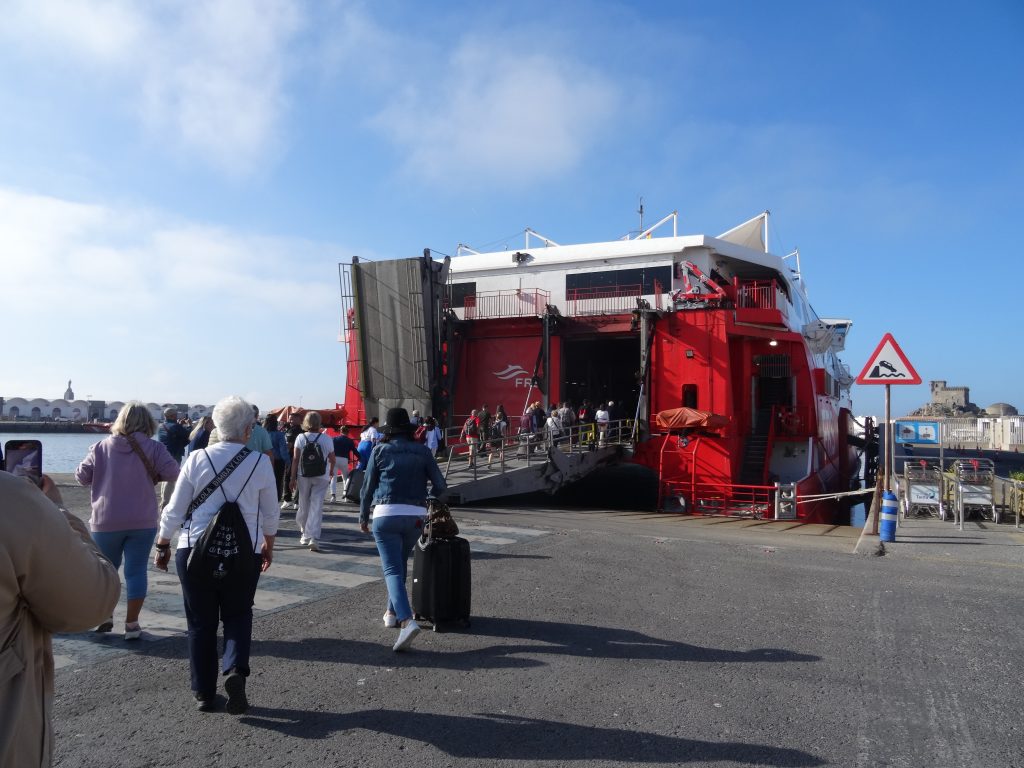
Catamaran ferry to Tangier 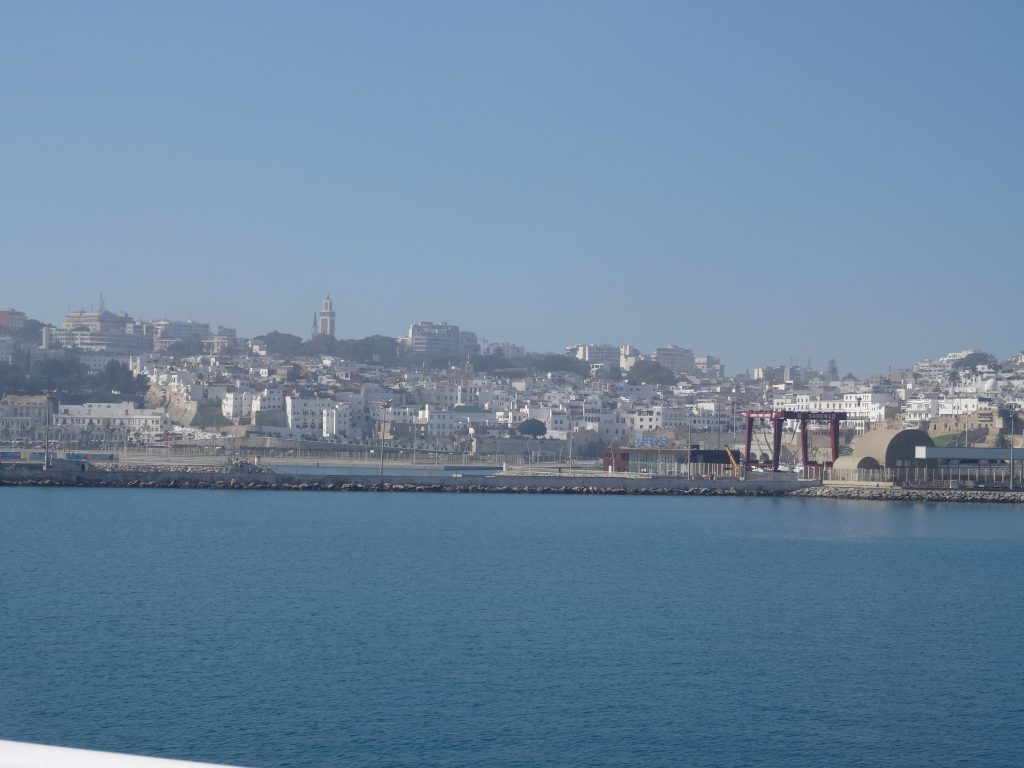
Hazy Harbour at Tangier 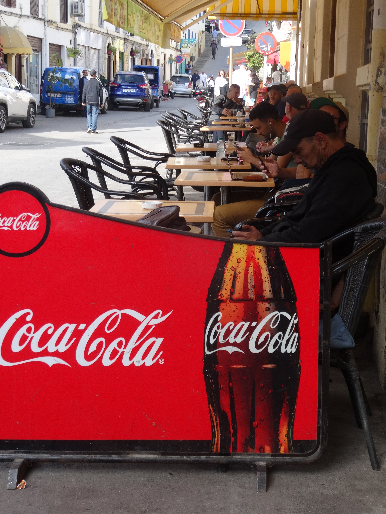
Men only Cafes? 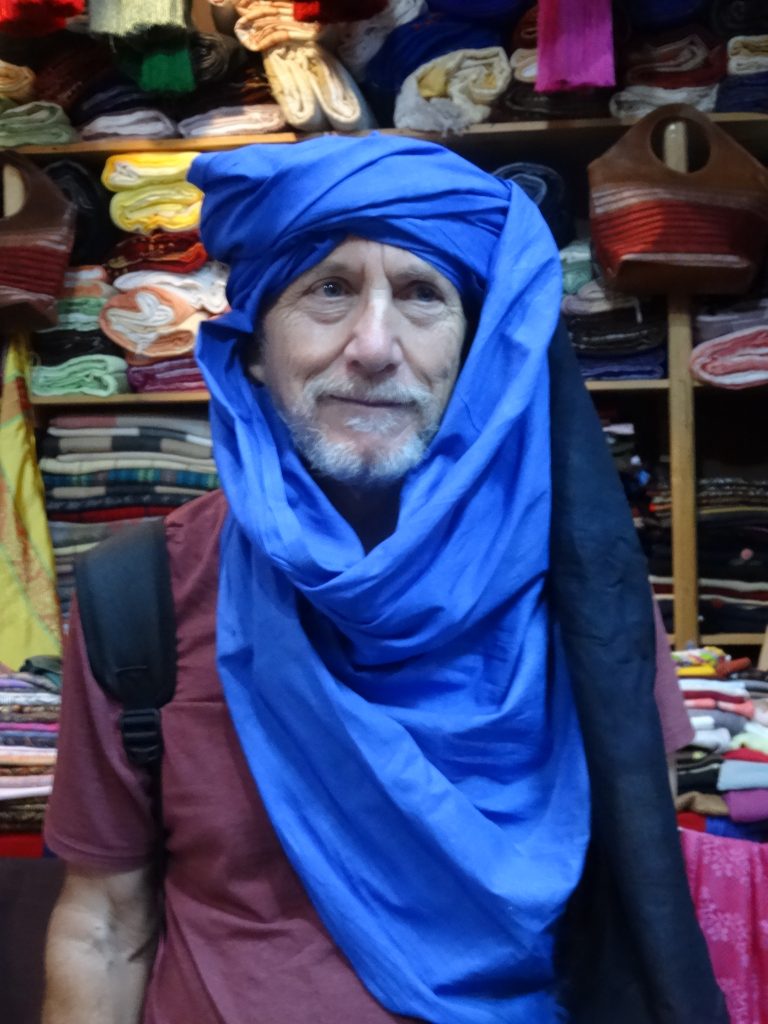
Glen of Tangier! 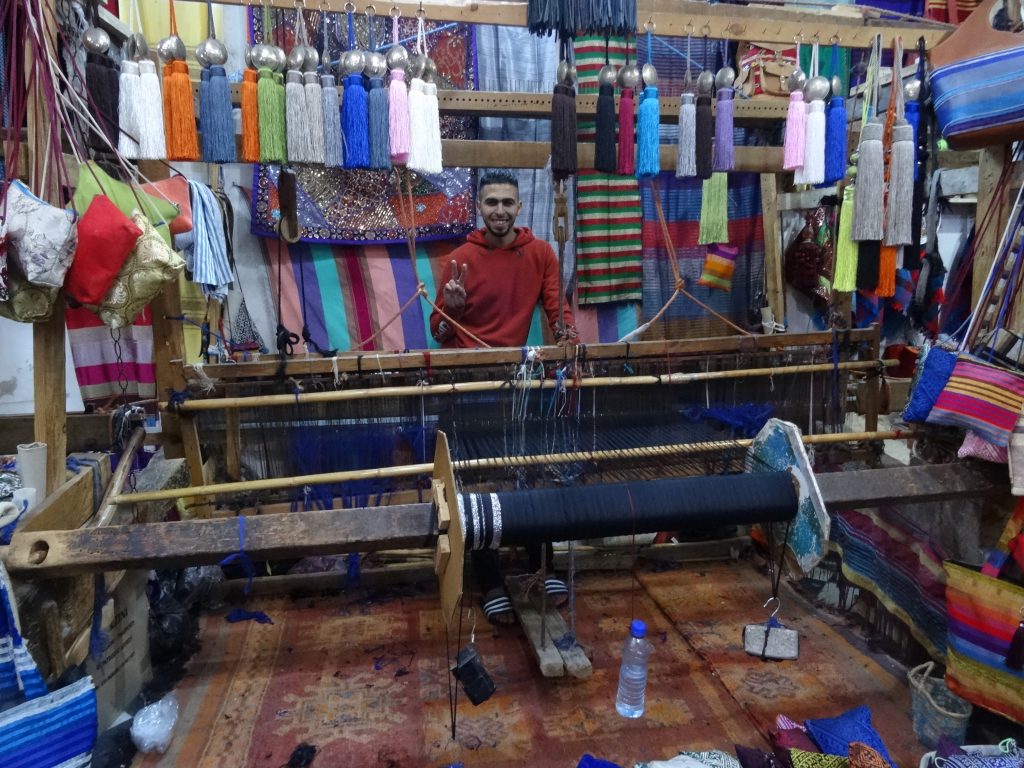
Weaver and Loom 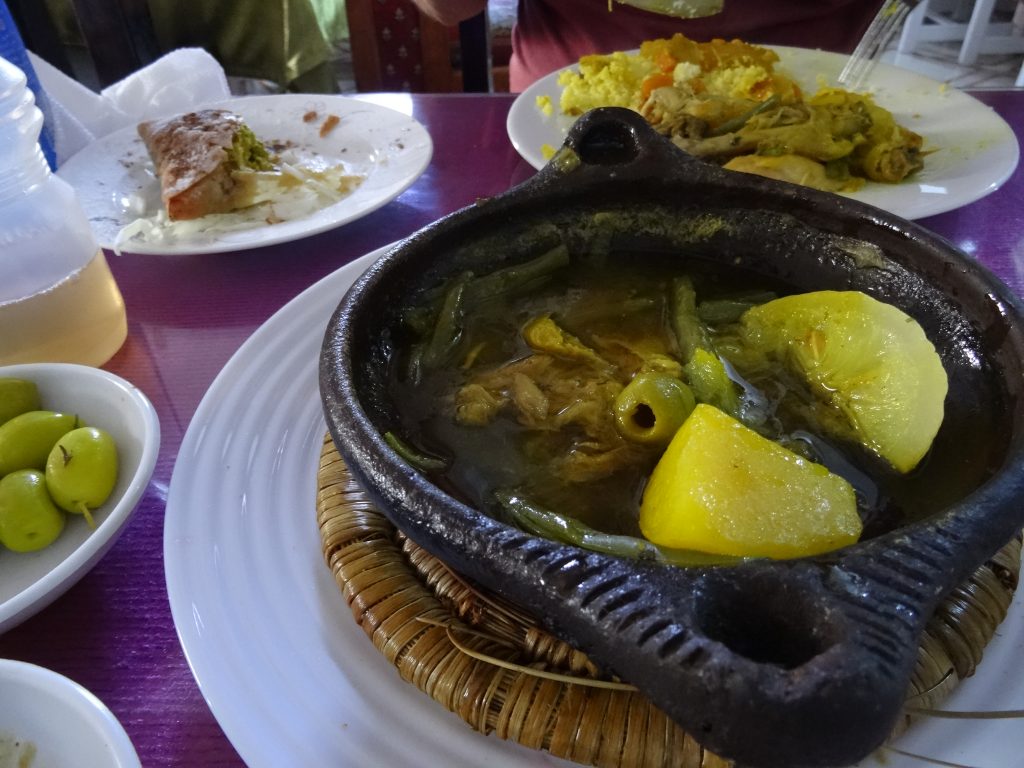
Fabulous chicken tagine 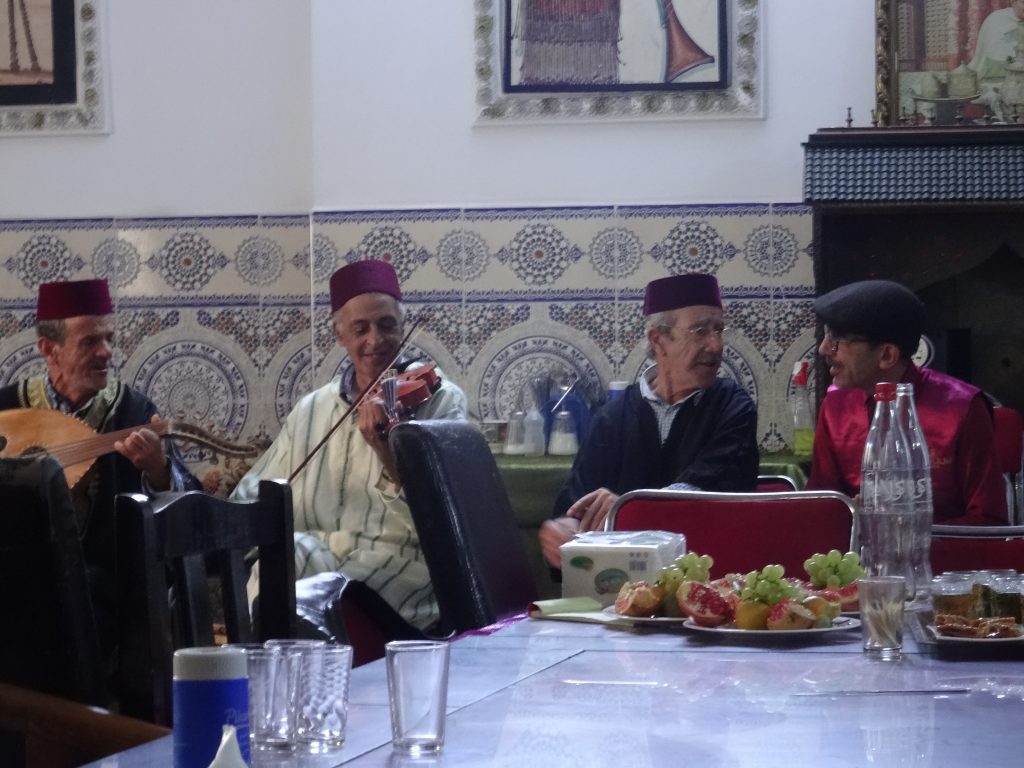
The Band 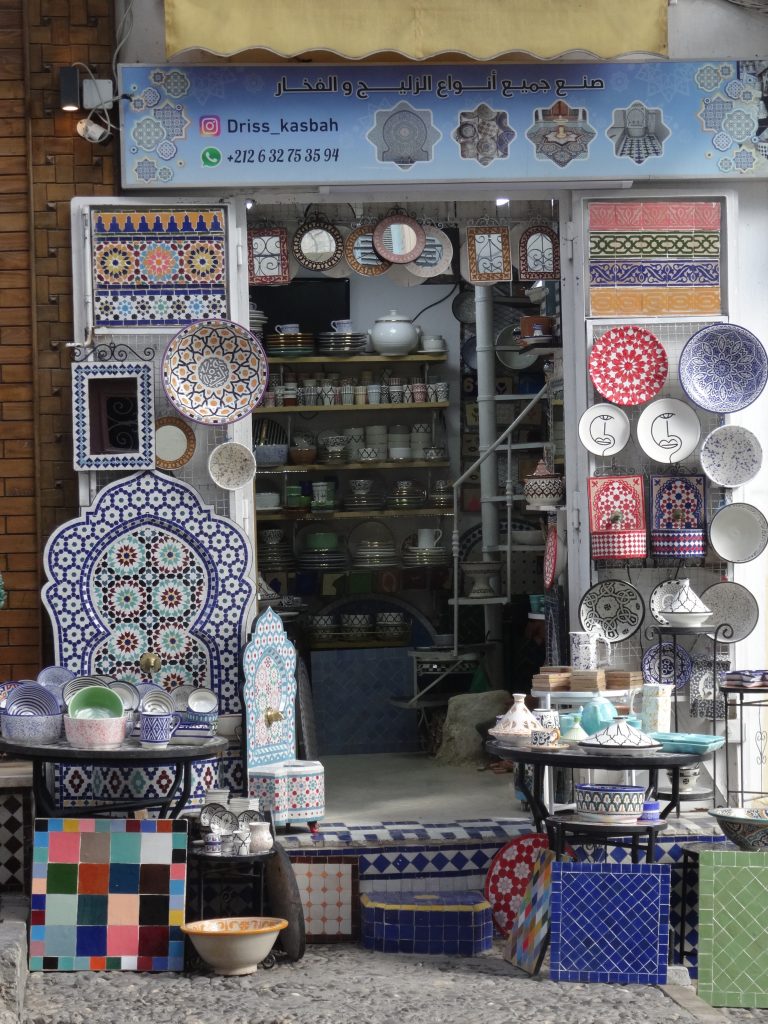
Pottery shop 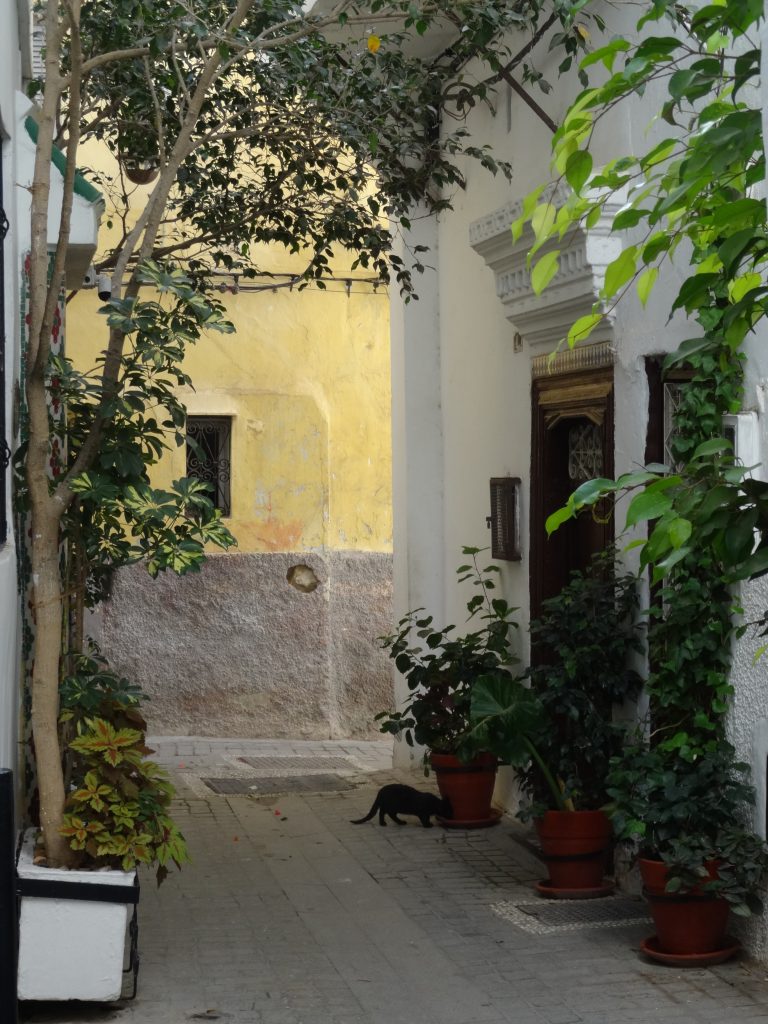
Medina alleyway